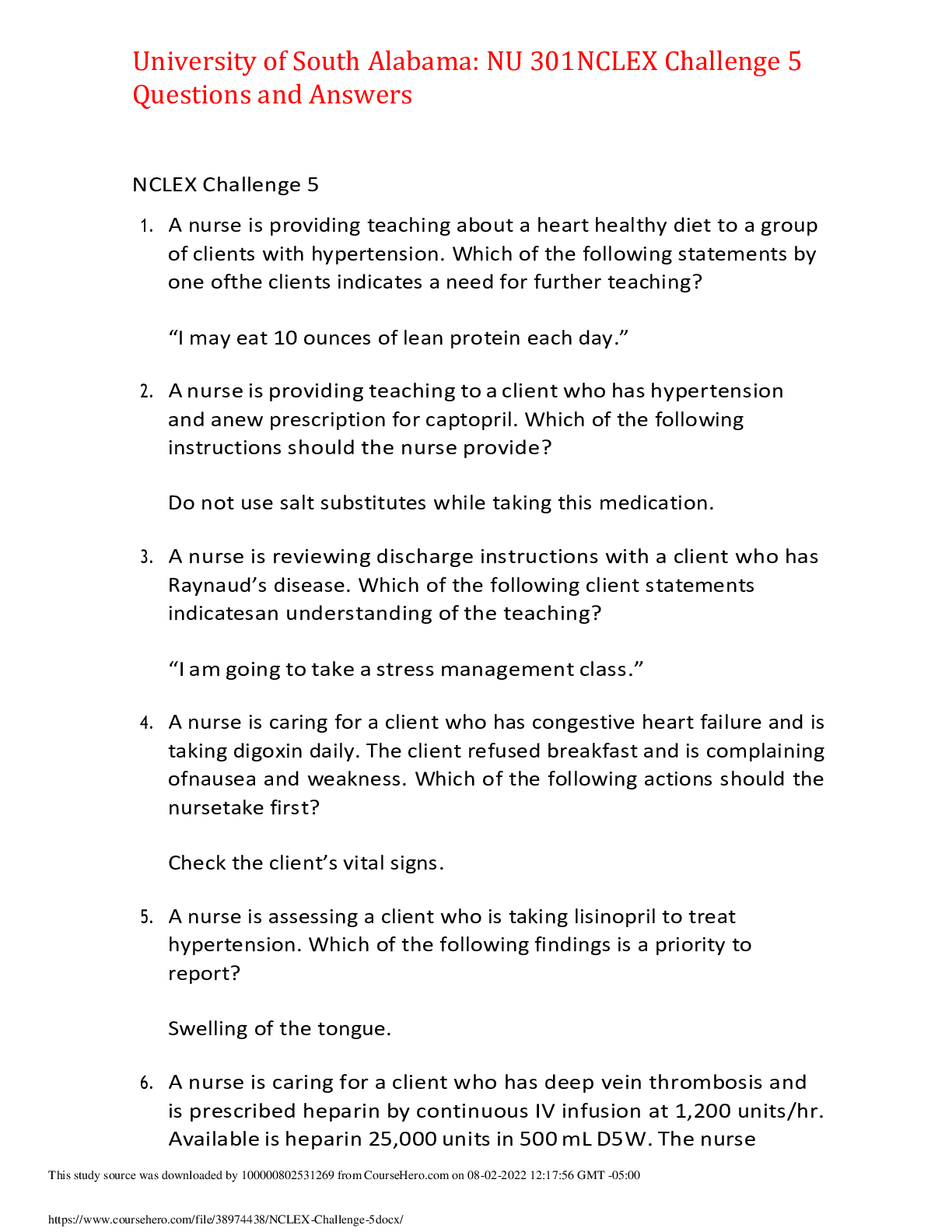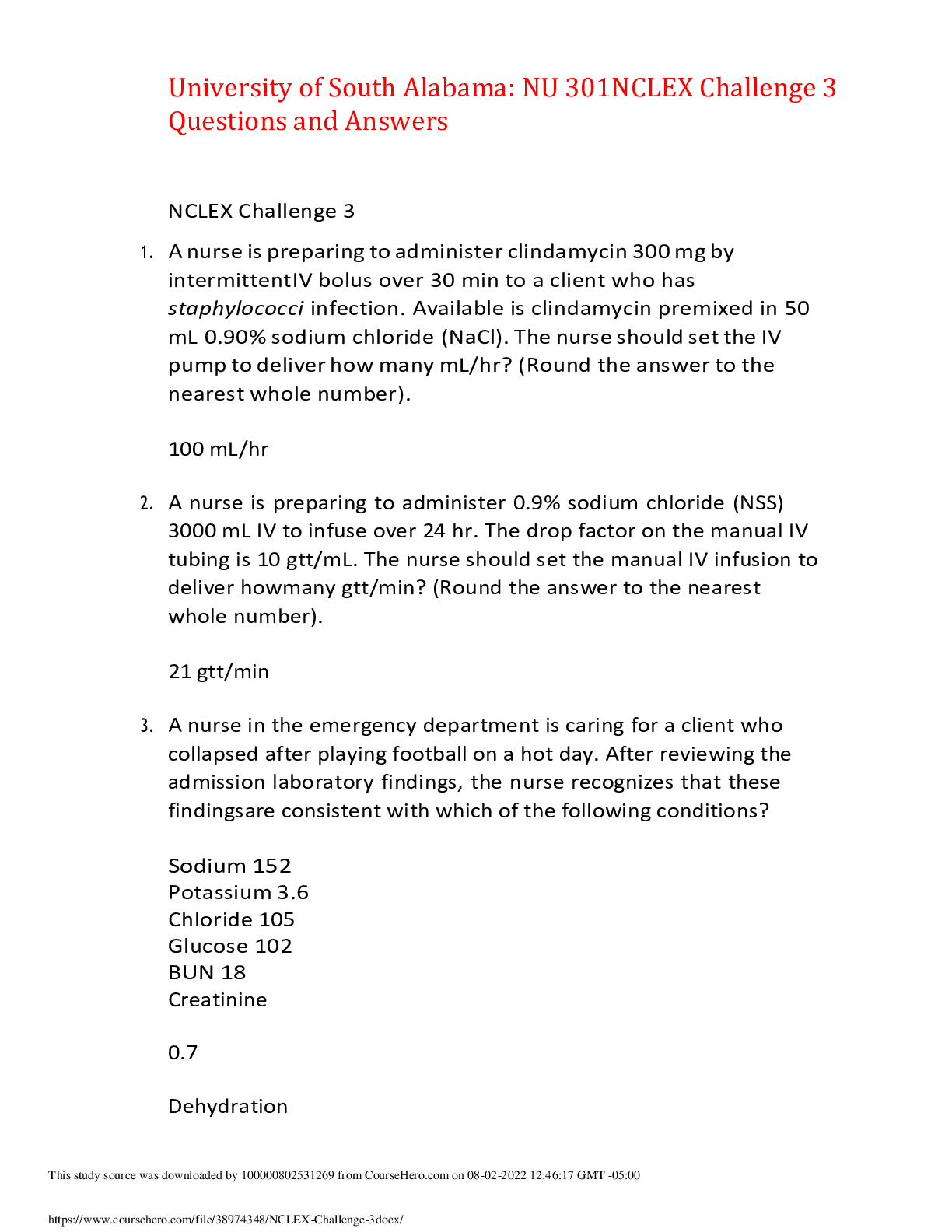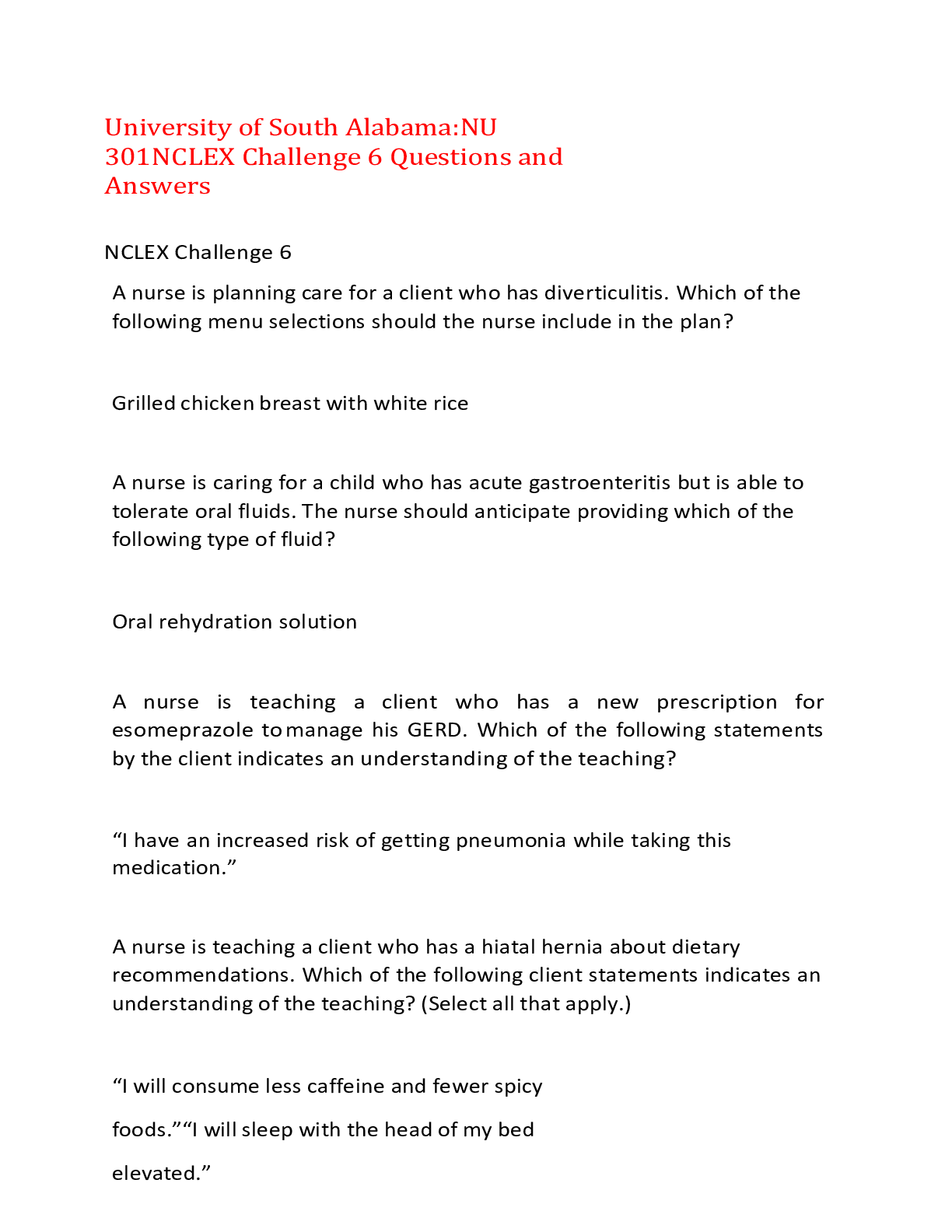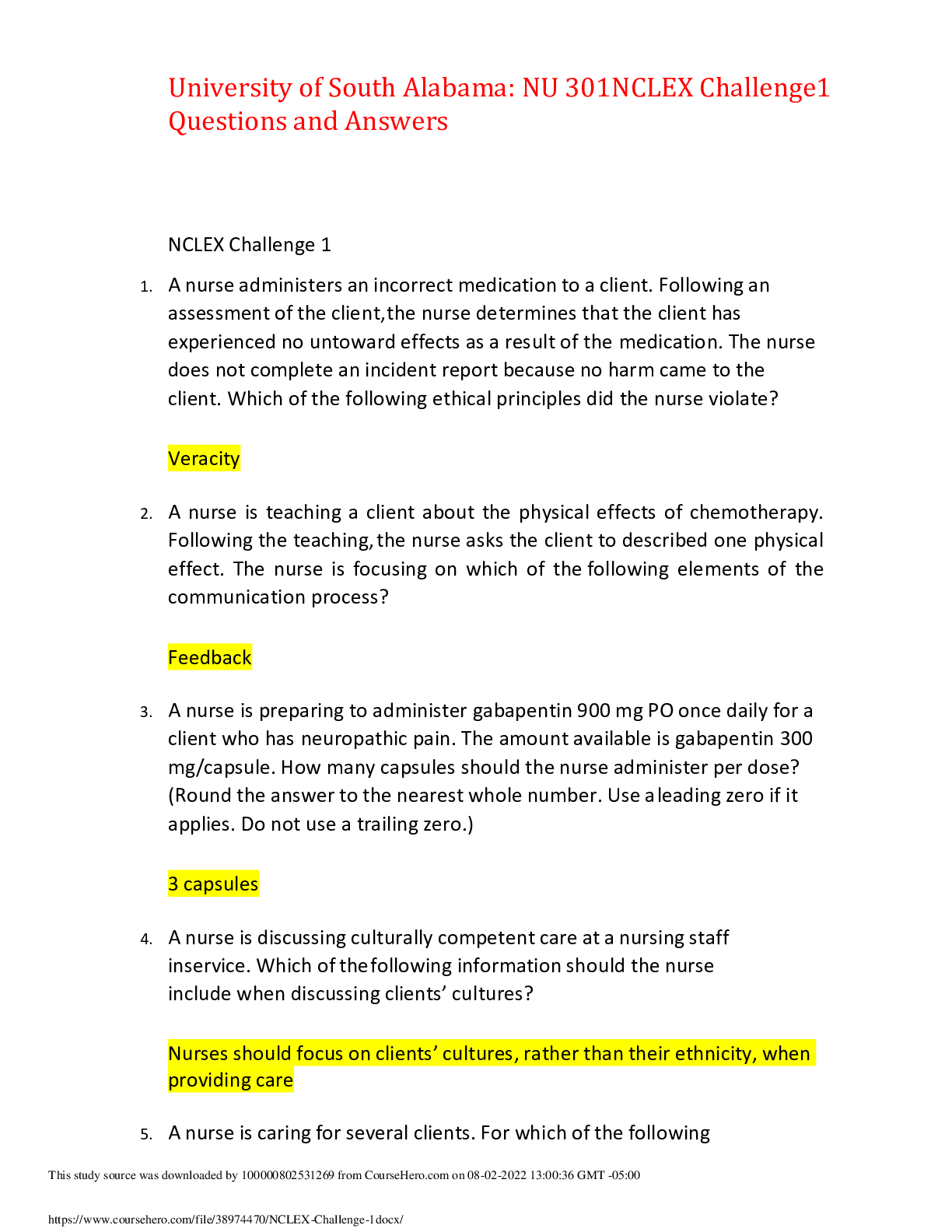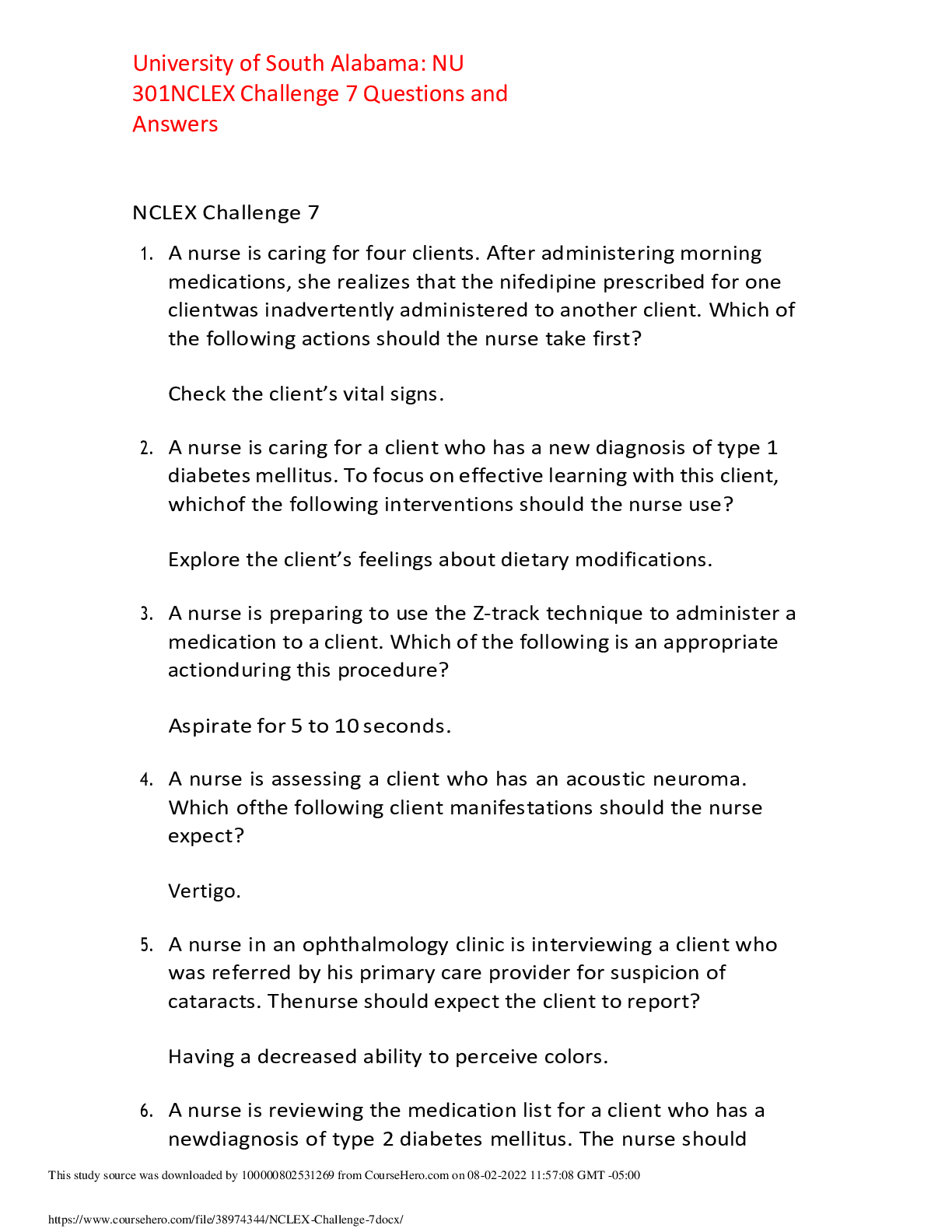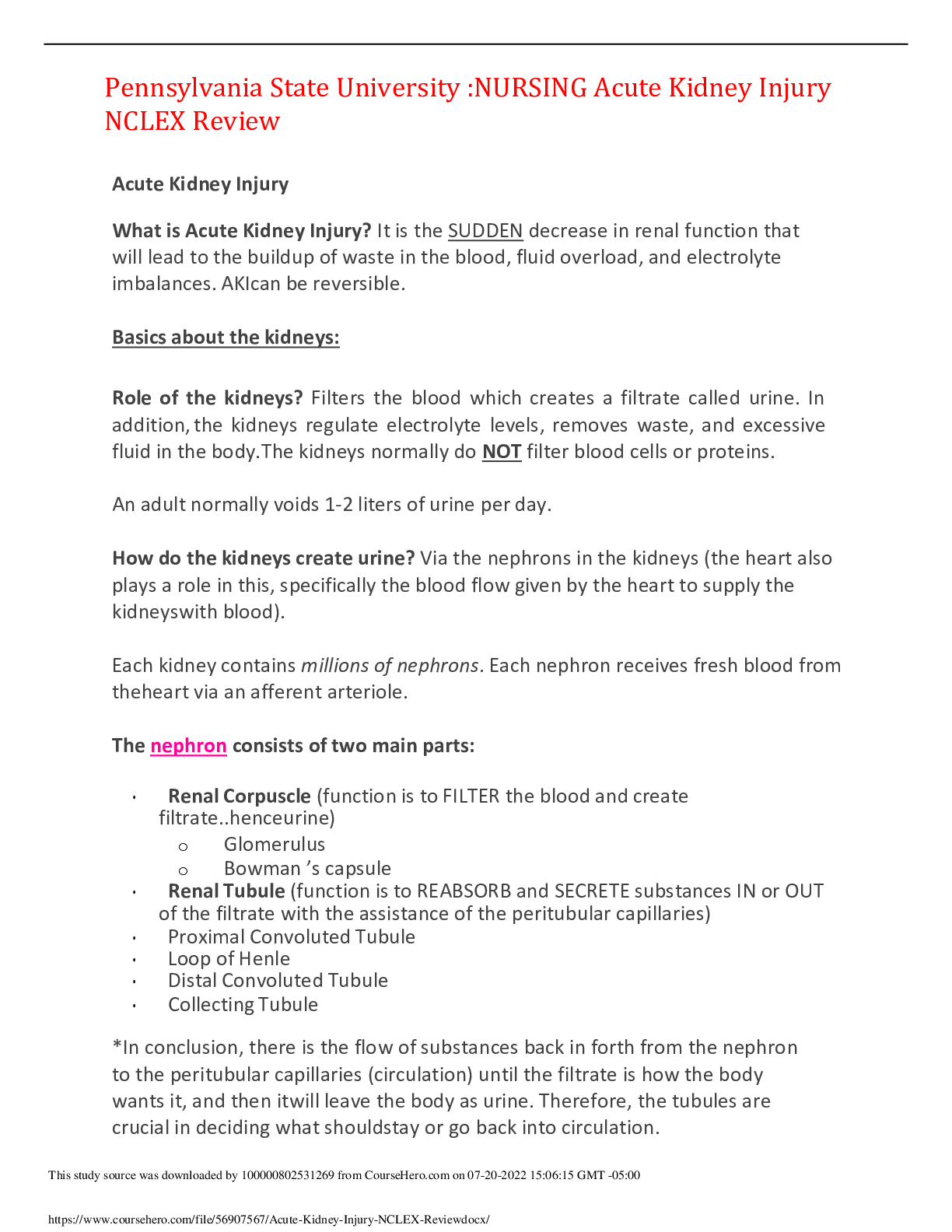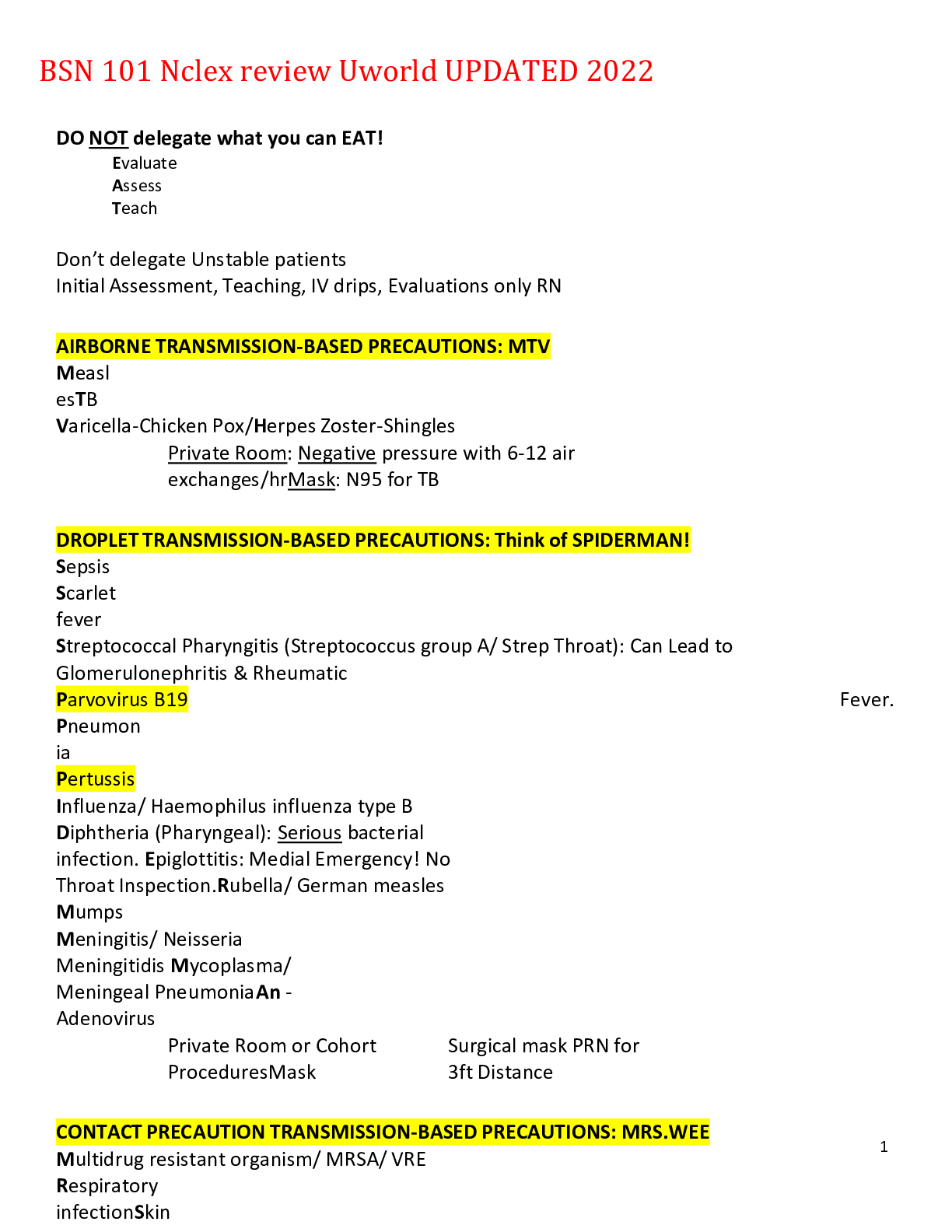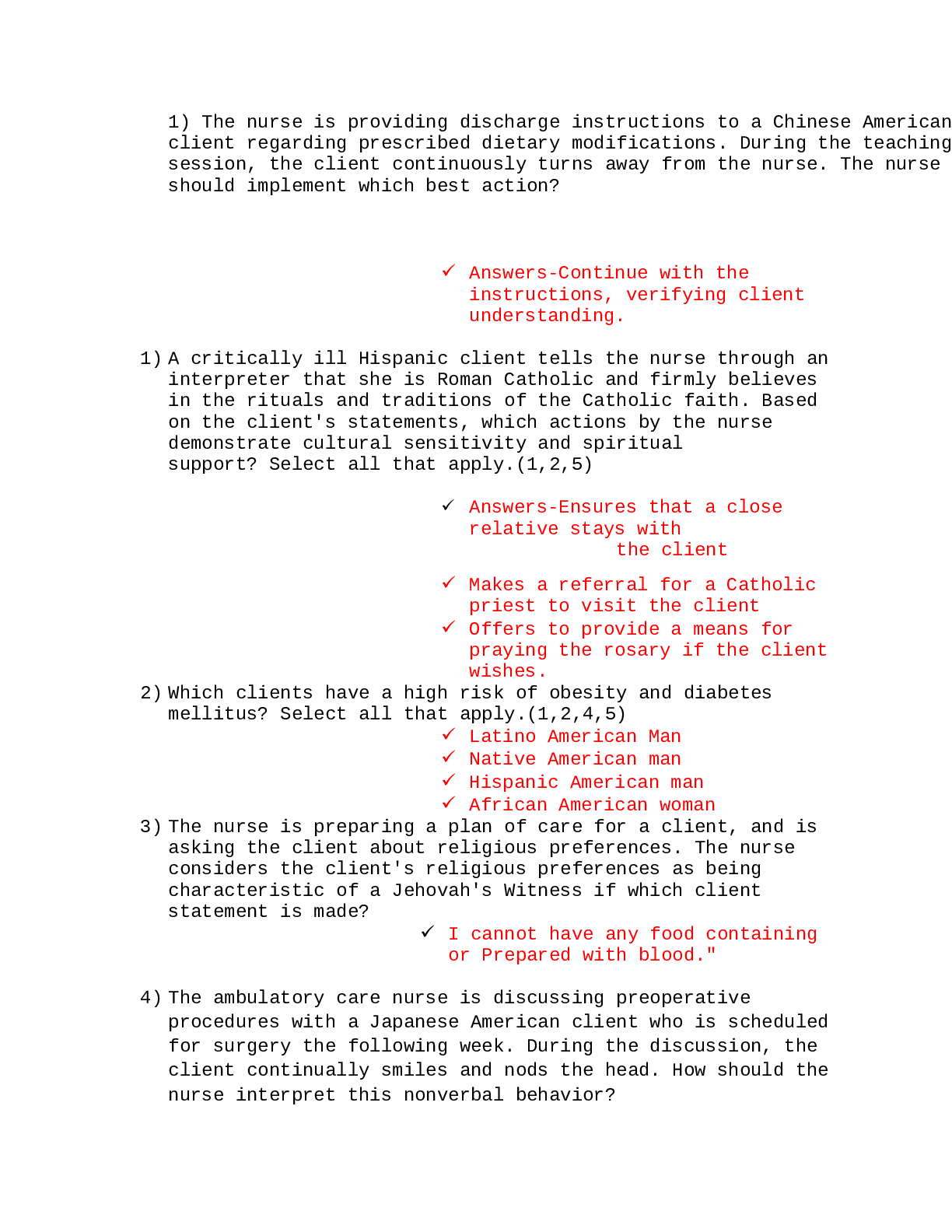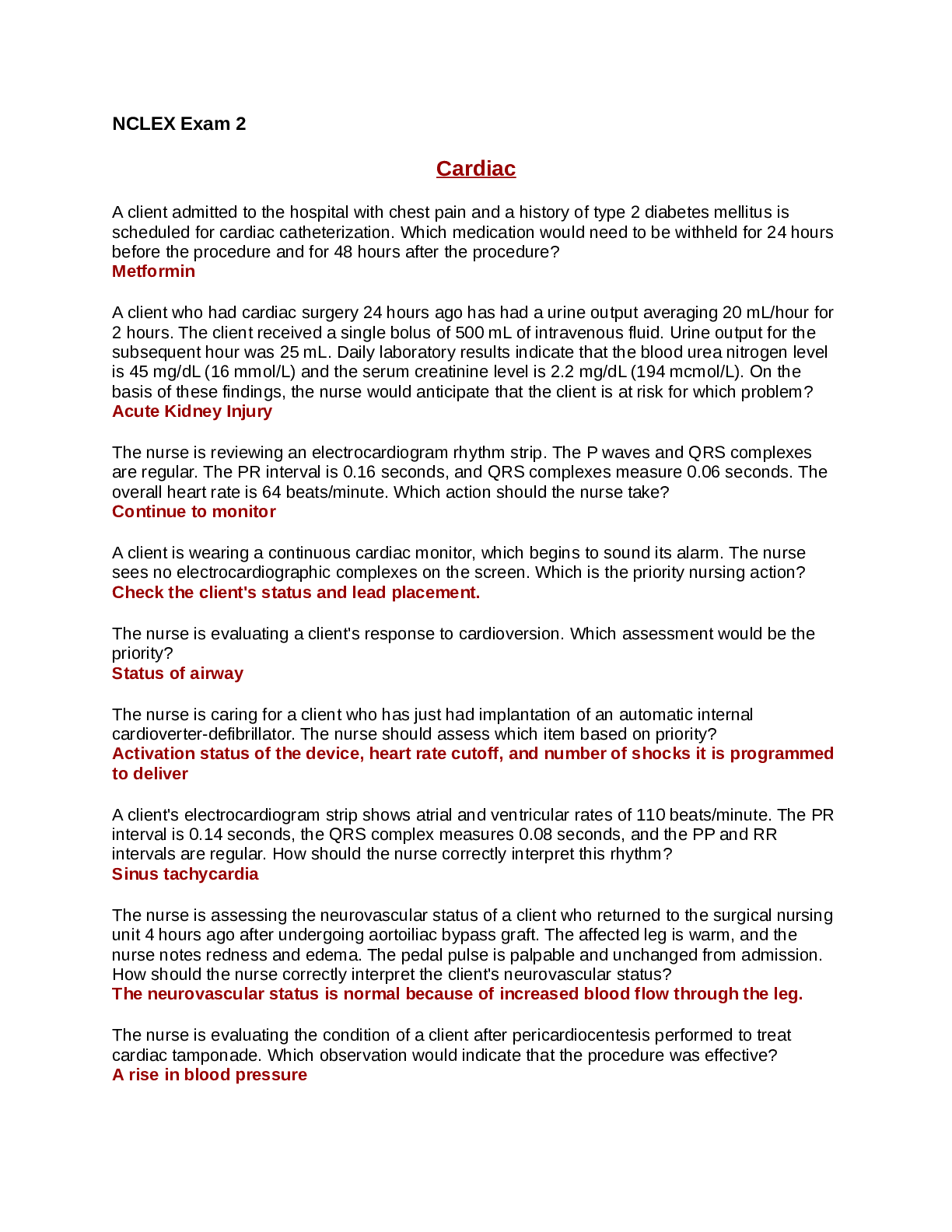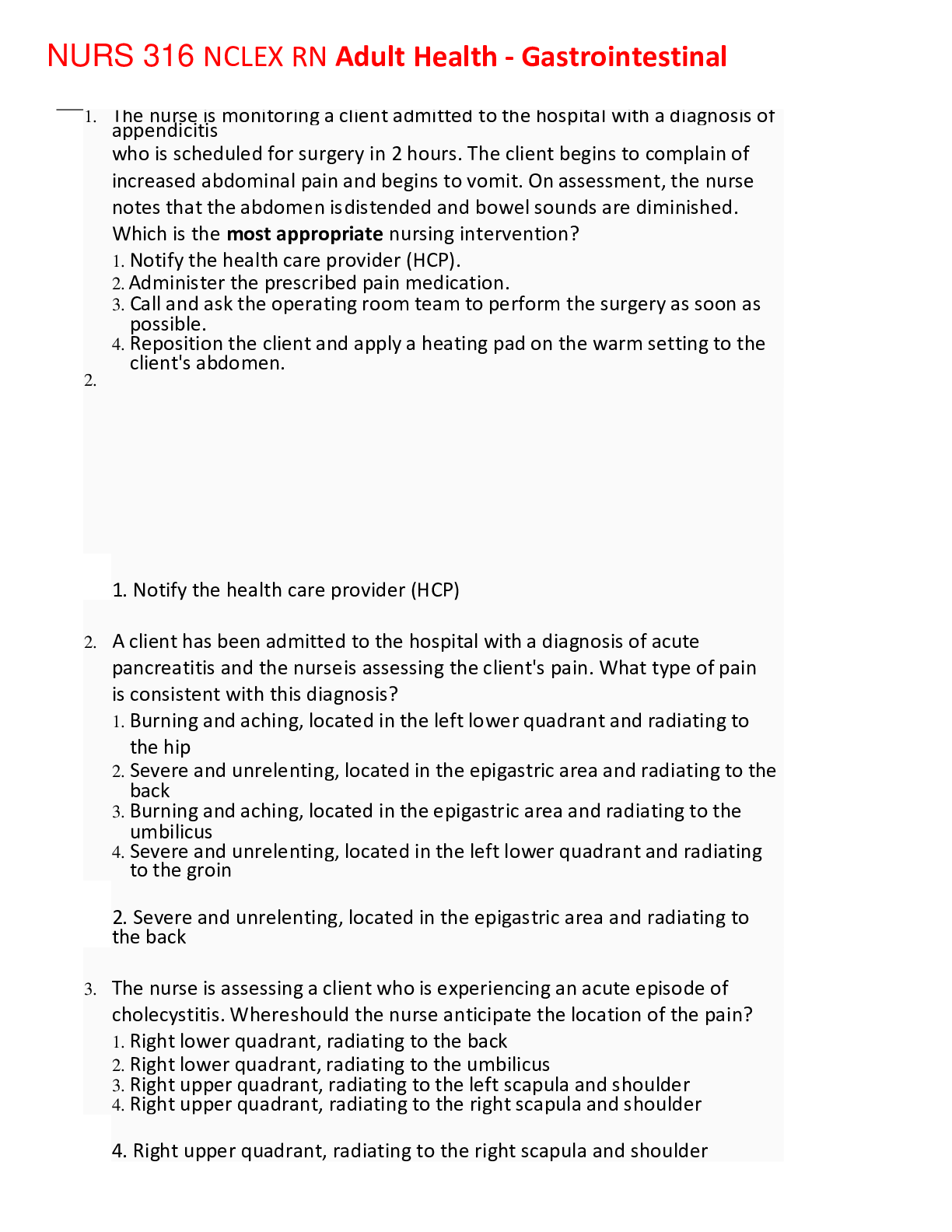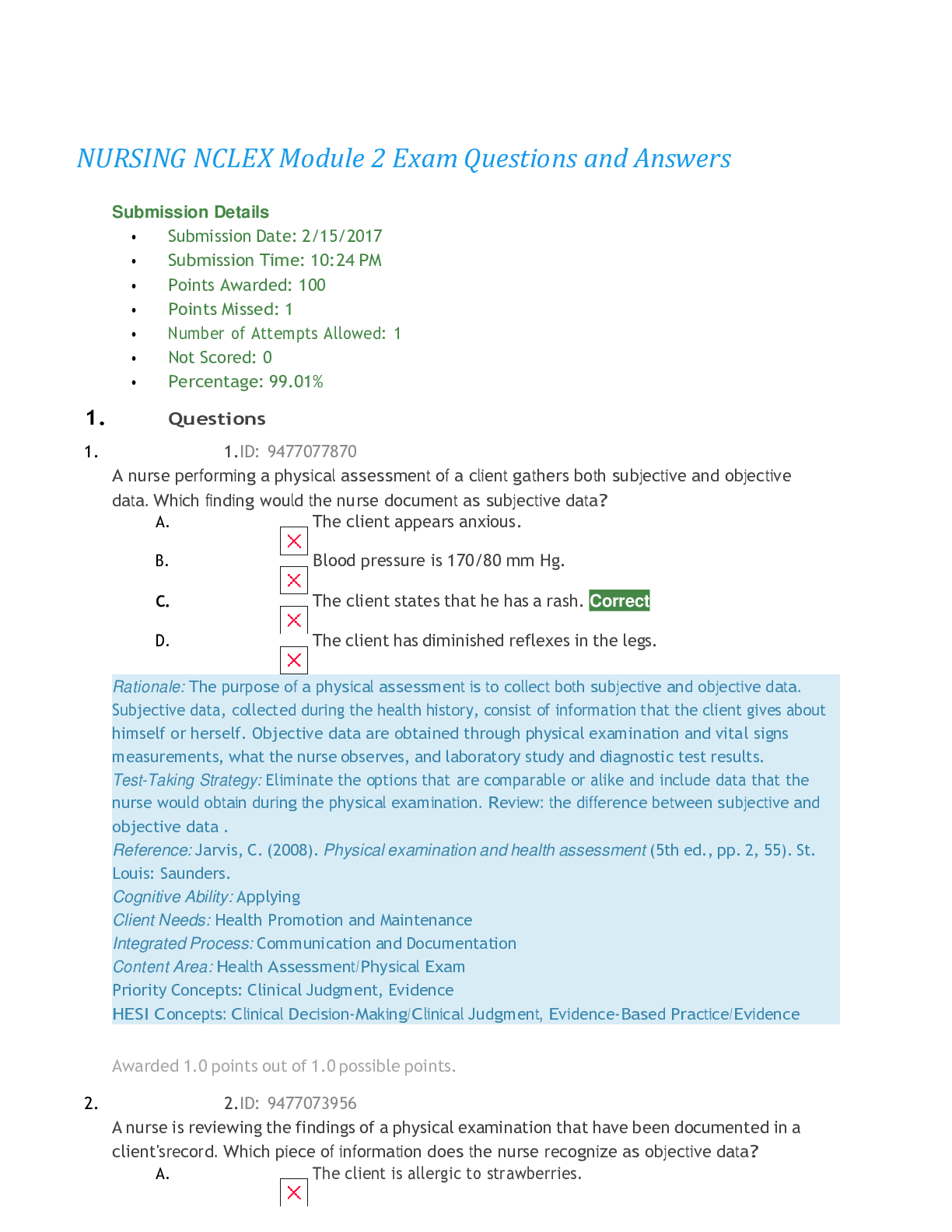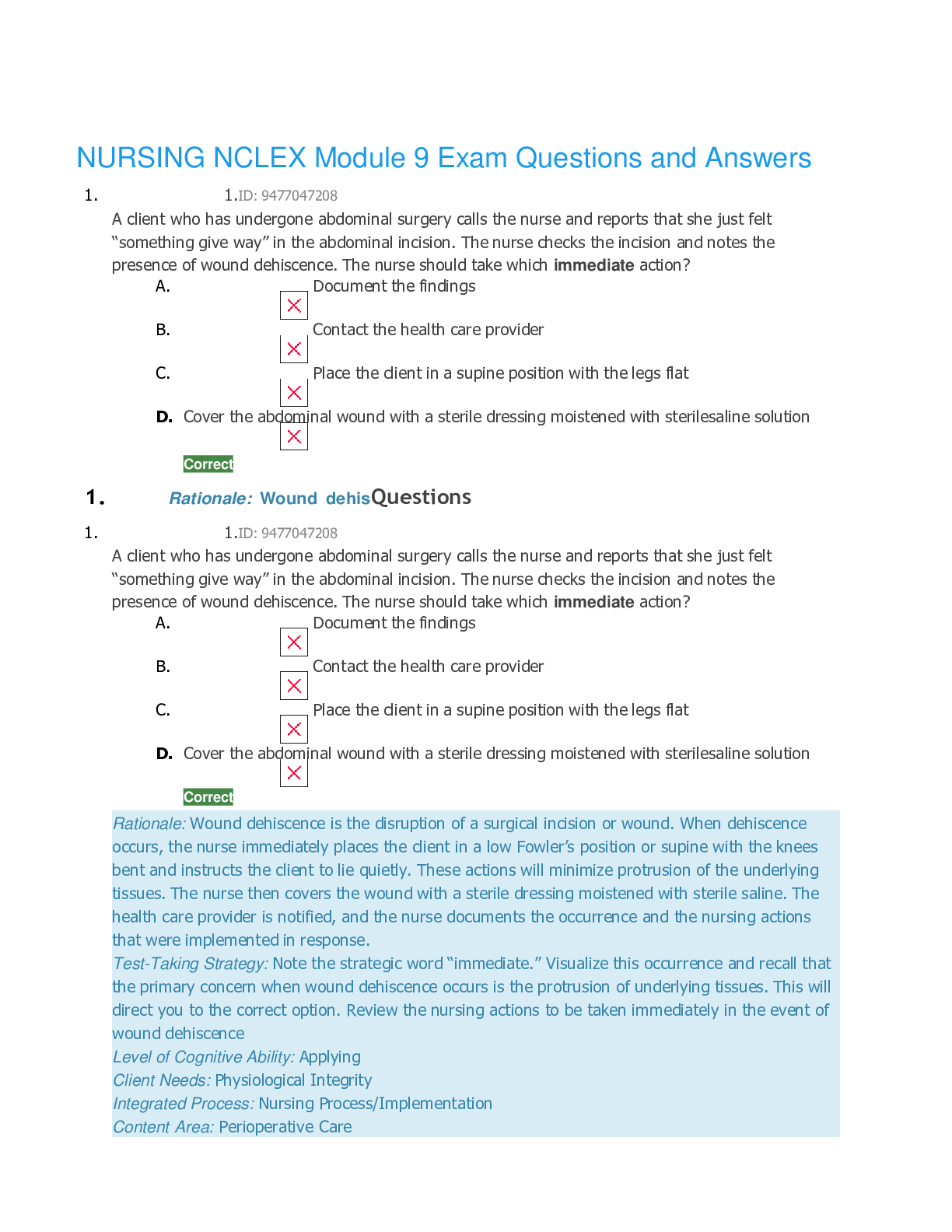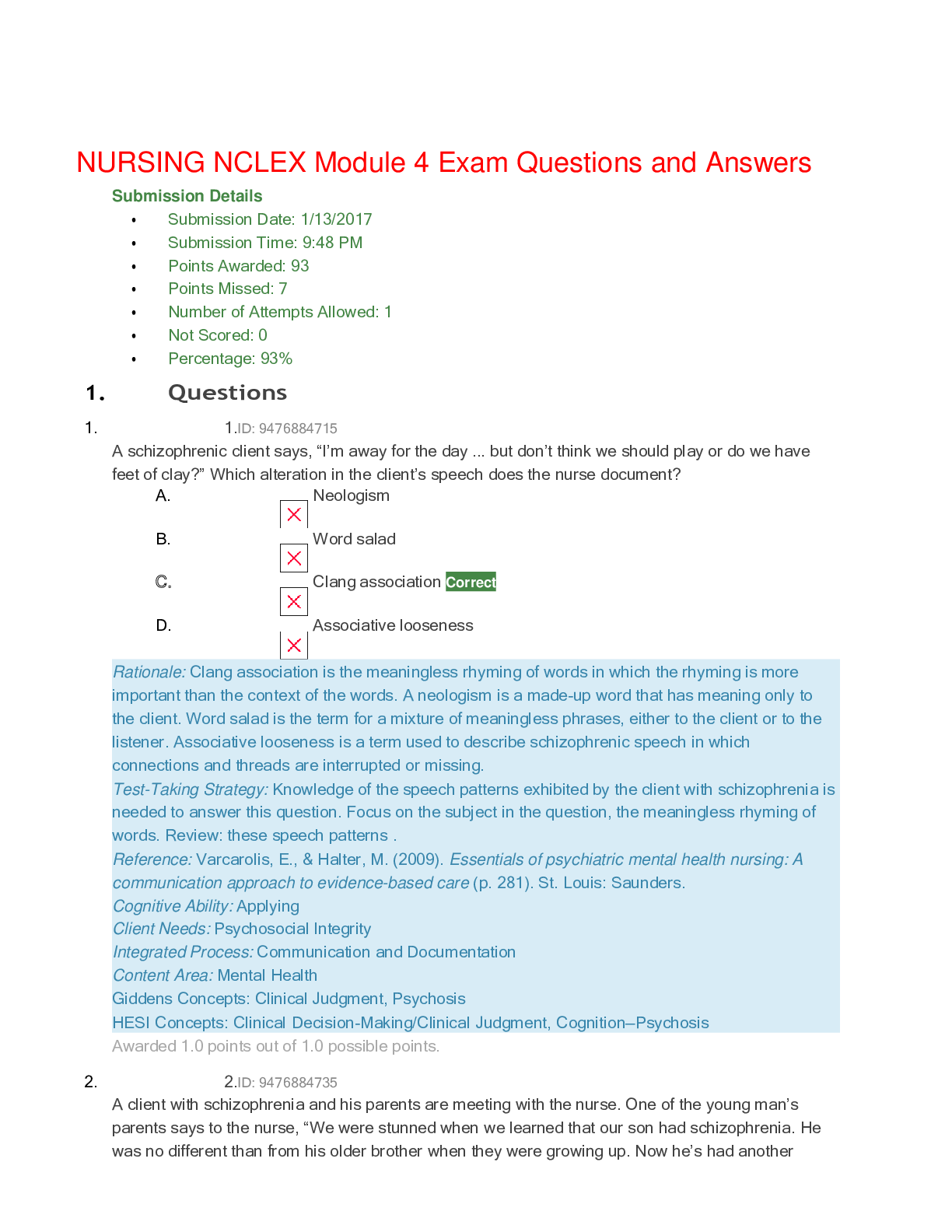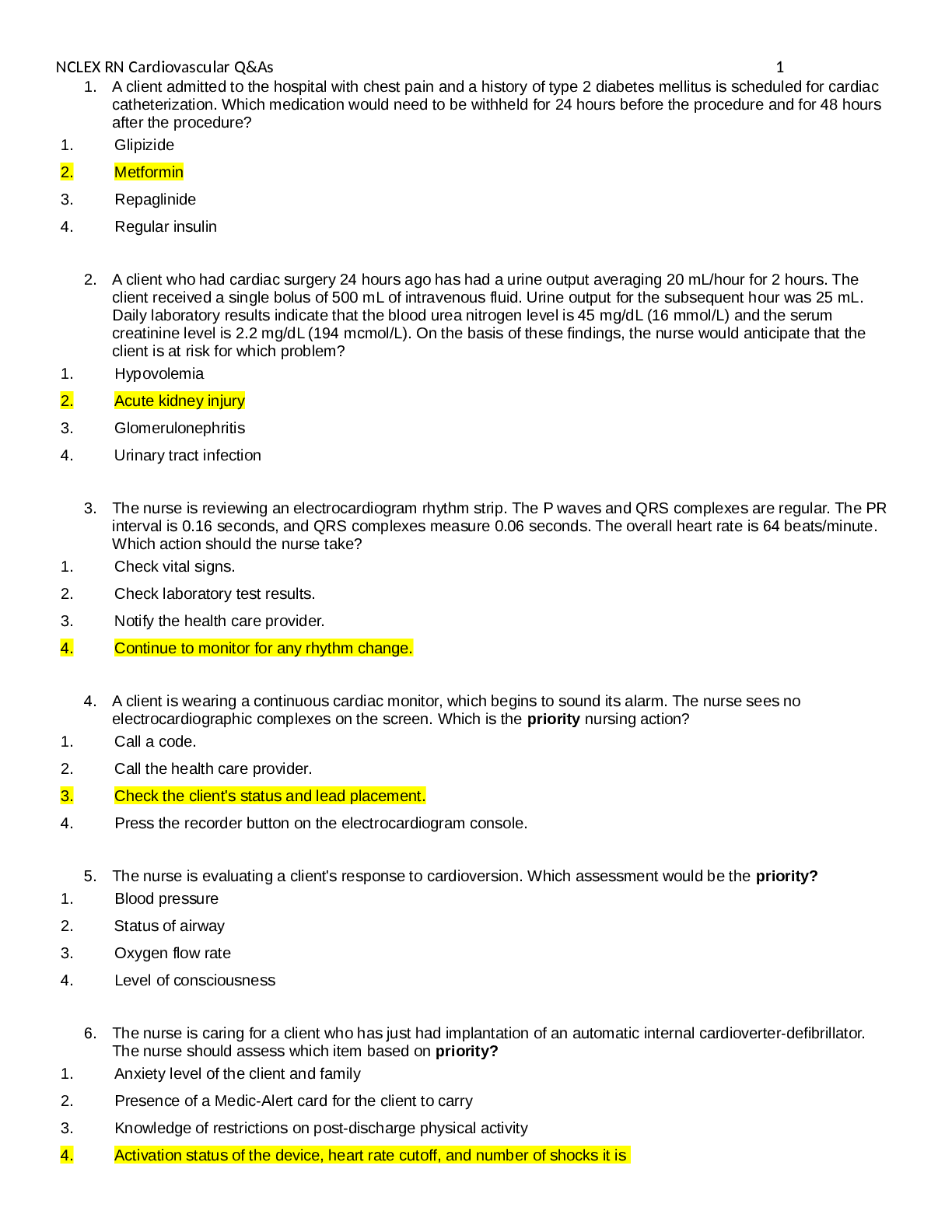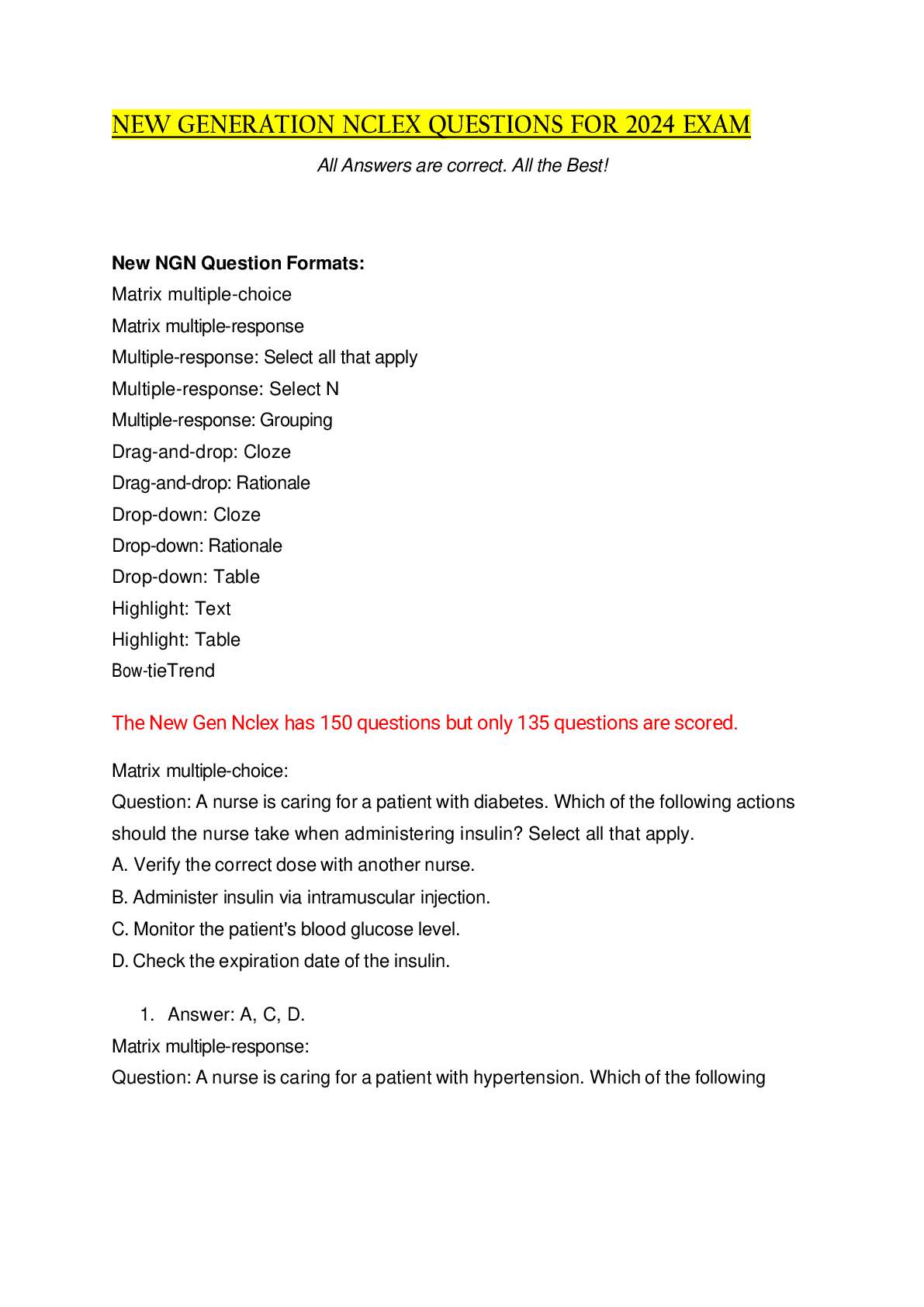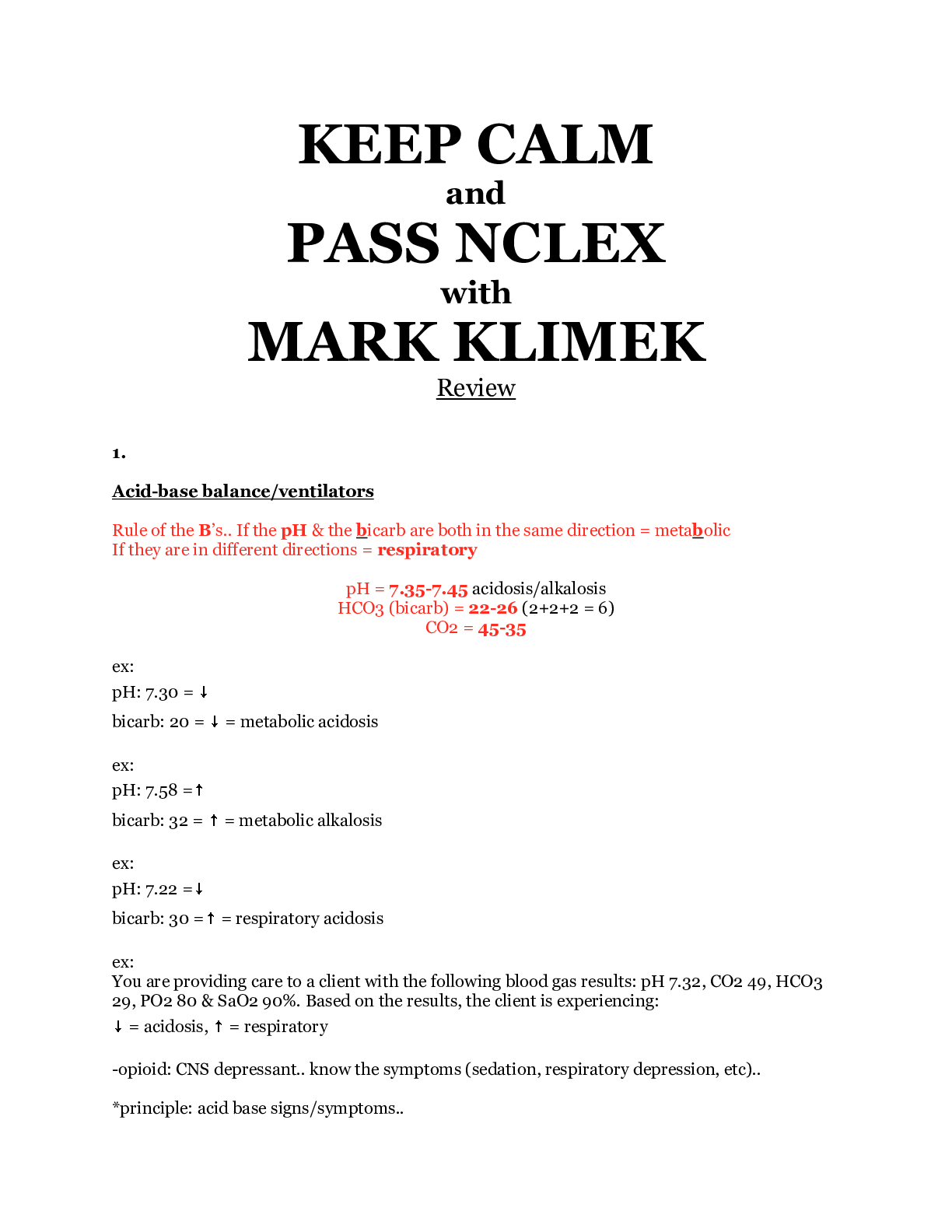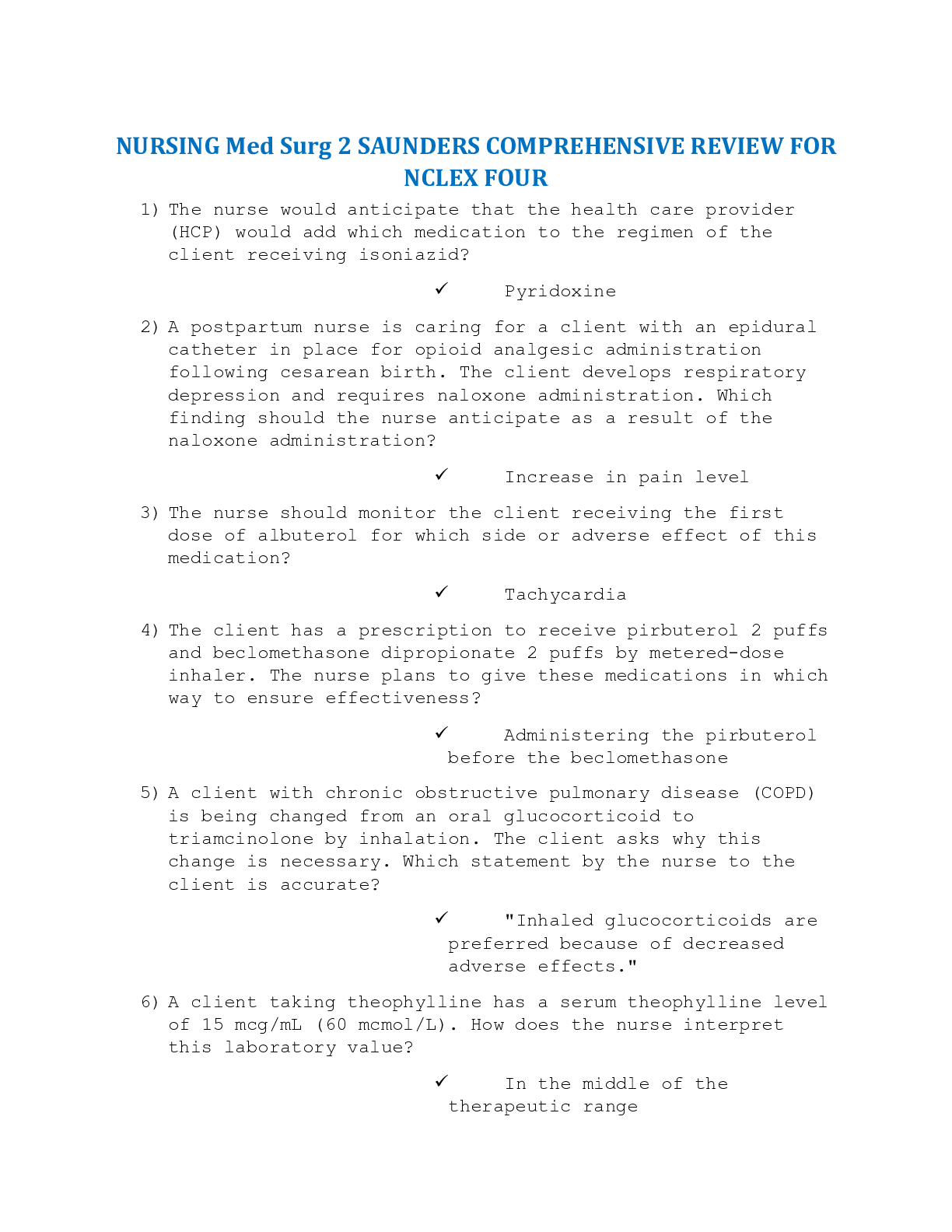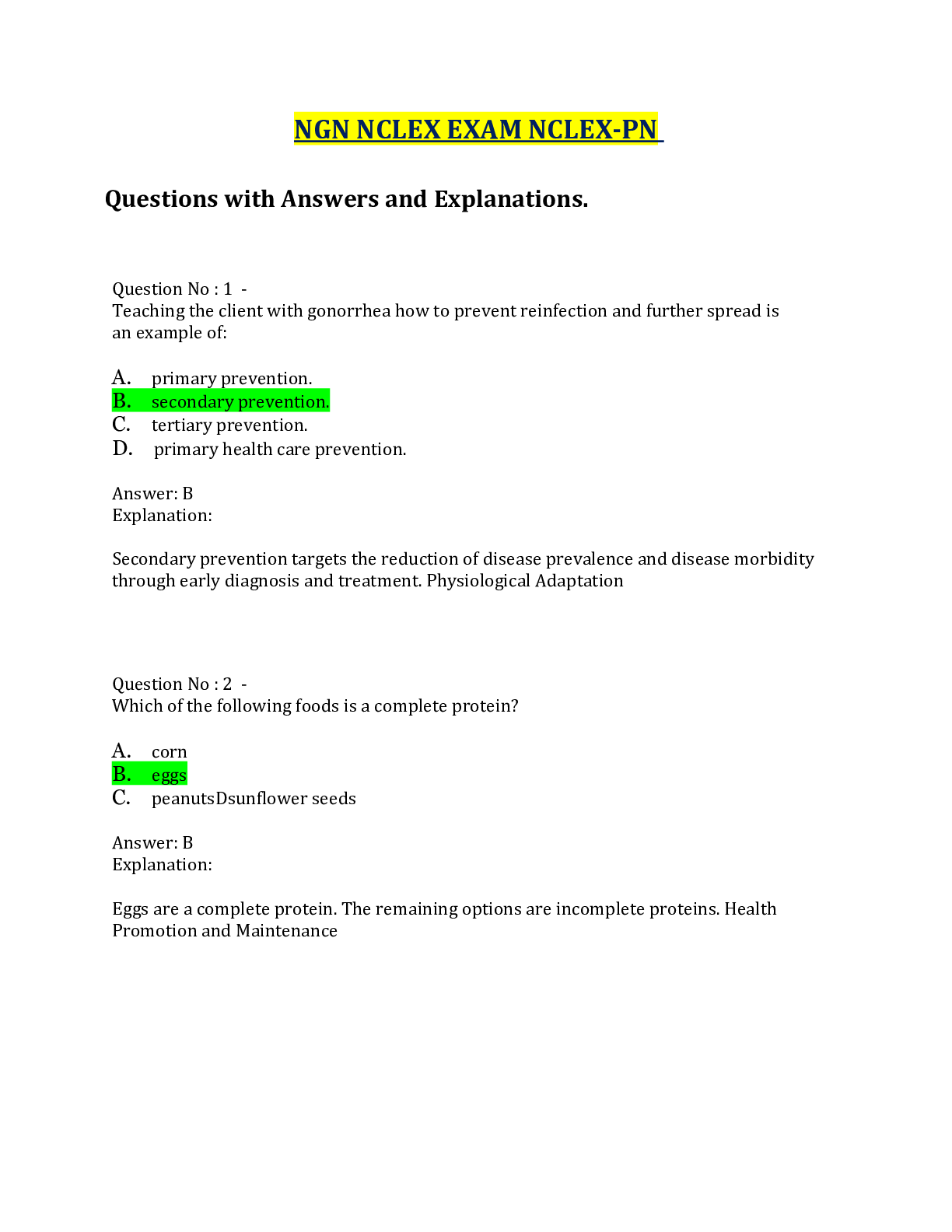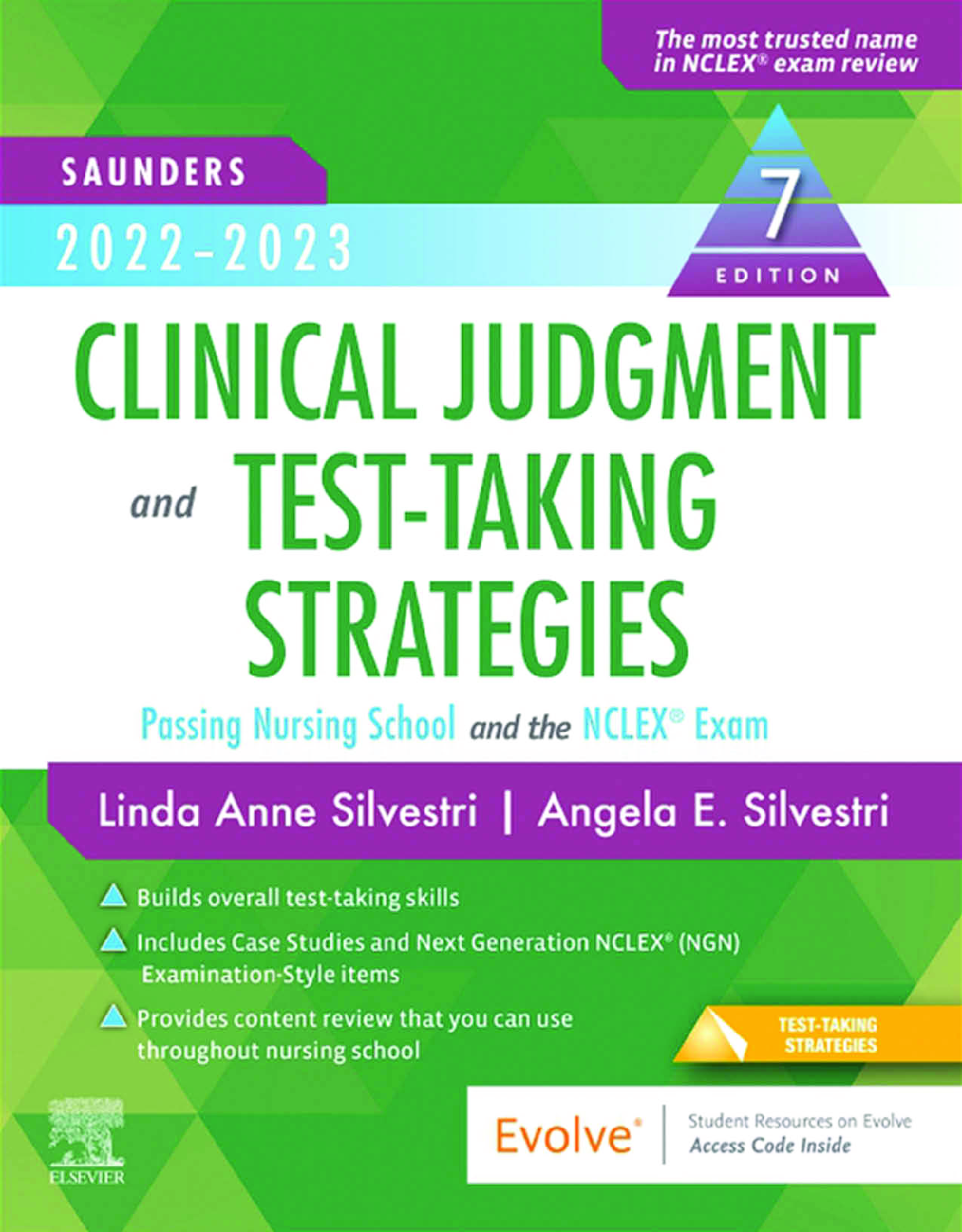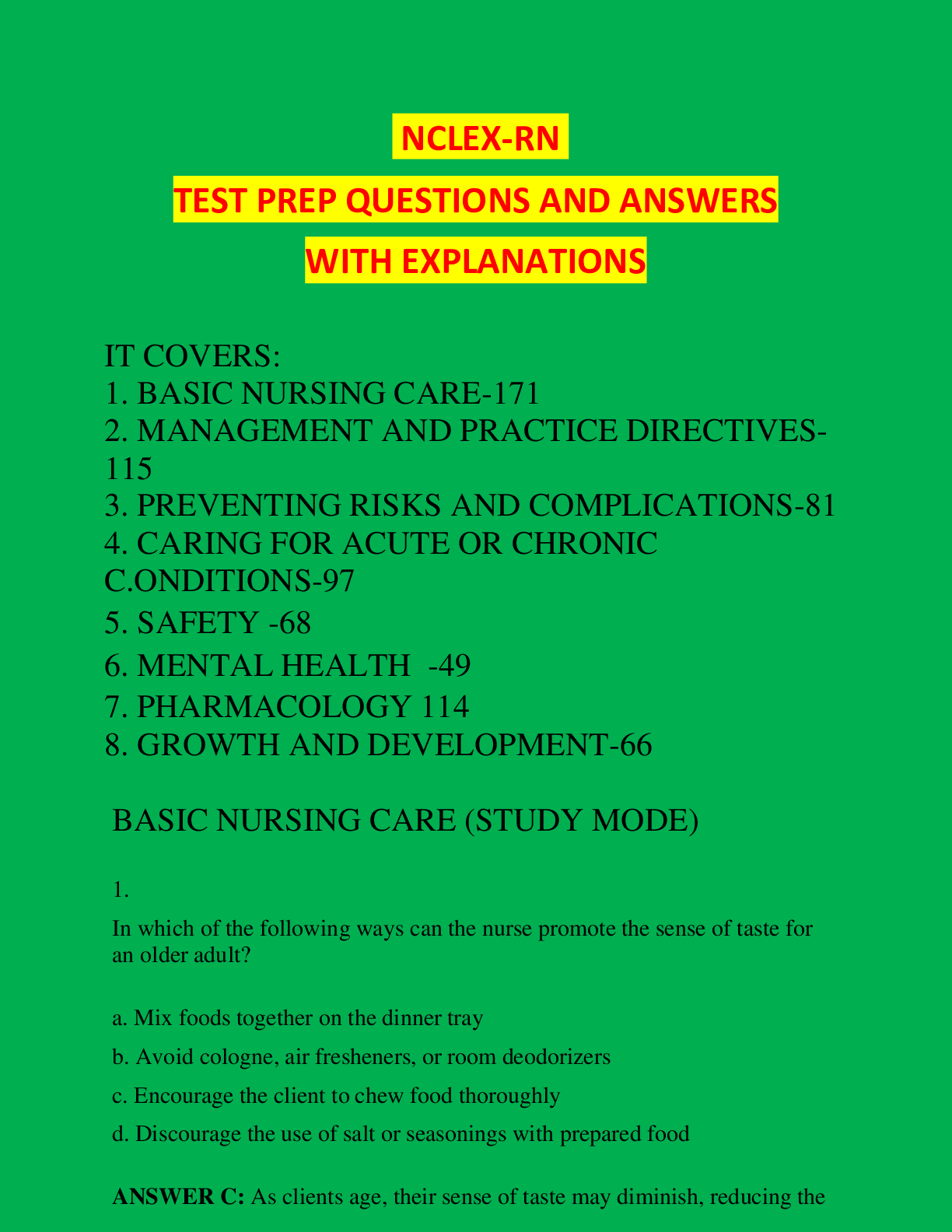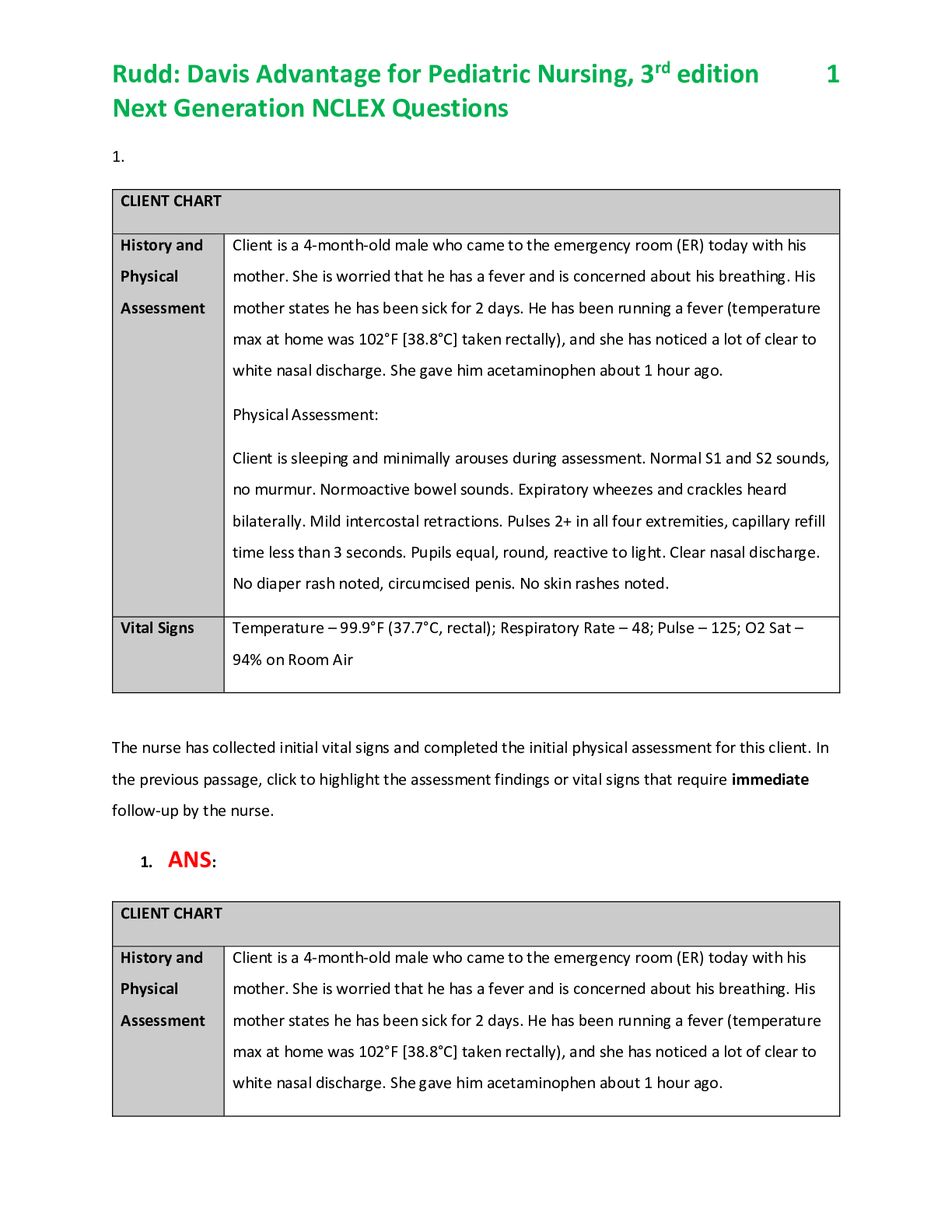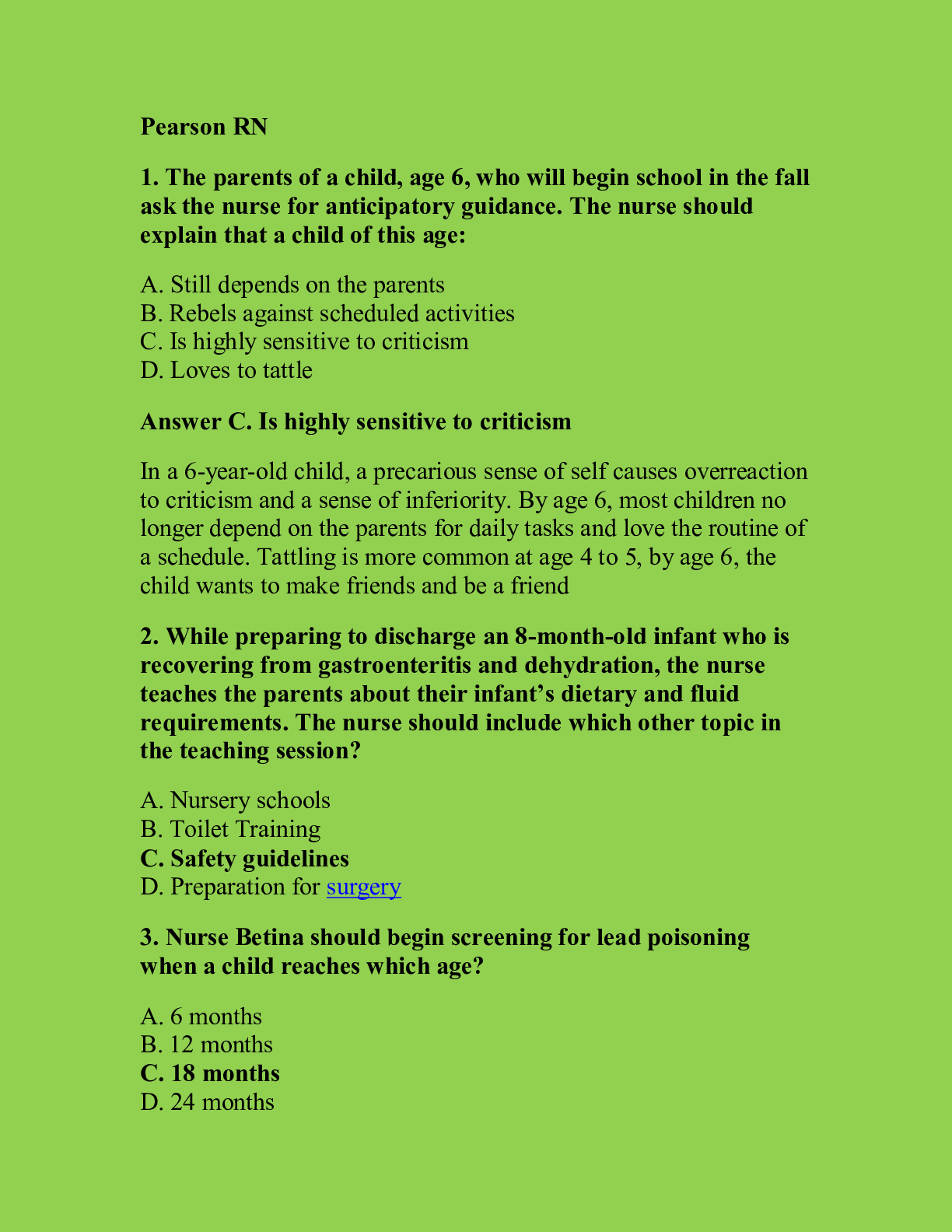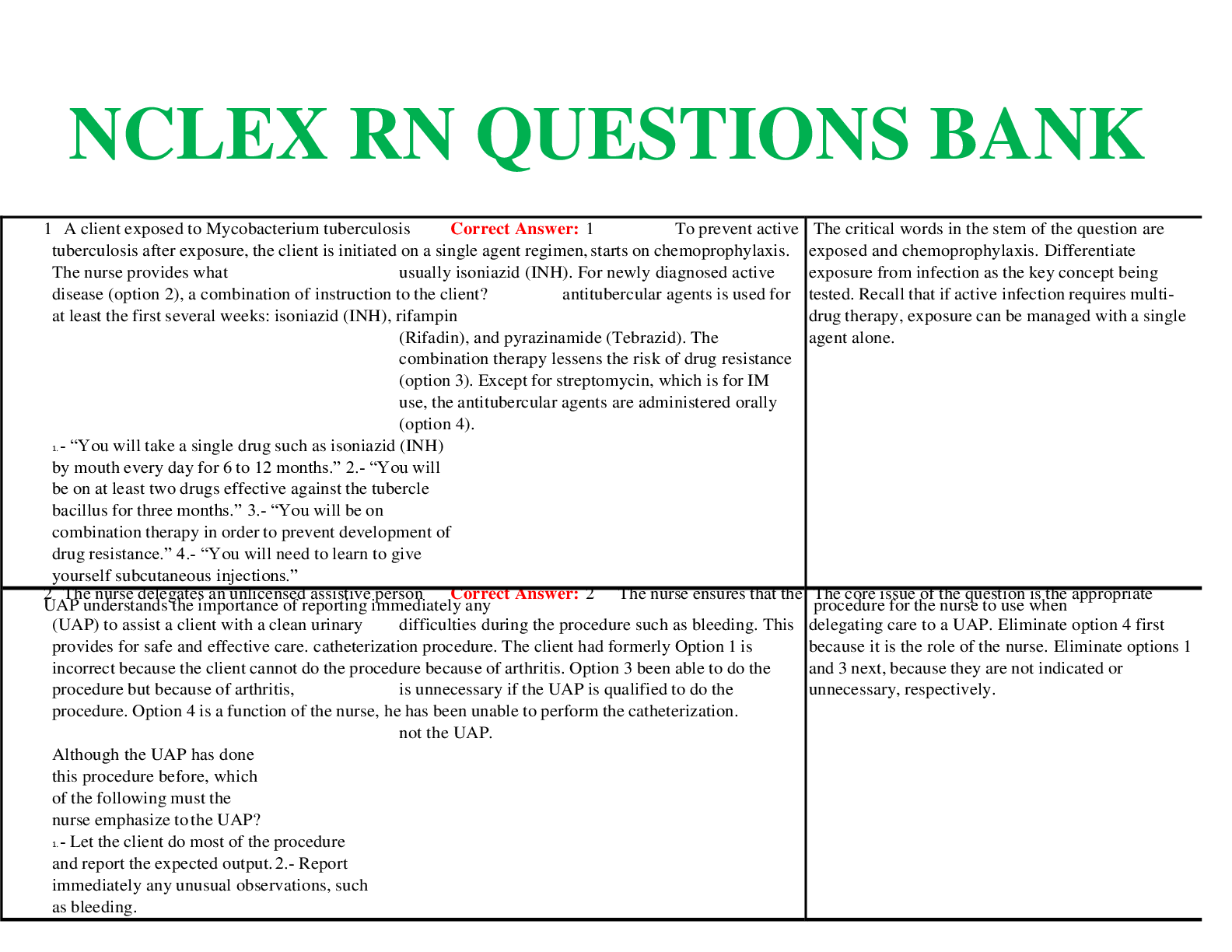RNSG 1250 Immunity Questions and Answers NCLEX,100% CORRECT
Document Content and Description Below
RNSG 1250 Immunity Questions and Answers NCLEX 1. The nurse provides home care instructions to a client with systemic lupus erythematosus and tells the client about methods to manage fatigue. Which s... tatement by the client indicates a need for further instruction? 1. "I should take hot baths because they are relaxing." 2. "I should sit whenever possible to conserve my energy." 3. "I should avoid long periods of rest because it causes joint stiffness." 4. "I should do some exercises, such as walking, when I am not fatigued." 2. The nurse is conducting a teaching session with a client on their diagnosis of pemphigus. Which statement by the client indicates that the client understands the diagnosis? 1. "My skin will have tiny red vesicles." 2. "The presence of the skin vesicles is caused by a virus." 3. "I have an autoimmune disease that causes blistering in the epidermis." 4. "The presence of red, raised papules and large plaques covered by silvery scales will be present on my skin." 3. The nurse is assisting in planning care for a client with a diagnosis of immunodeficiency and should incorporate which action as a priority in the plan? 1. Protecting the client from infection 2. Providing emotional support to decrease fear 3. Encouraging discussion about lifestyle changes 4. Identifying factors that decreased the immune function 4. A client calls the nurse in the emergency department and states that he was just stung by a bumblebee while gardening. The client is afraid of a severe reaction because the client's neighbor experienced such a reaction just 1 week ago. Which action should the nurse take? 1. Advise the client to soak the site in hydrogen peroxide. 2. Ask the client if he ever sustained a bee sting in the past. 3. Tell the client to call an ambulance for transport to the emergency department. 4. Tell the client not to worry about the sting unless difficulty with breathing occurs. Rationale: In some types of allergies, a reaction occurs only on second and subsequent contacts with the allergen. The appropriate action, therefore, would be to ask the client if he ever experienced a bee sting in the past. Option 1 is not appropriate advice. Option 3 is unnecessary. The client should not be told "not to worry." 5. The community health nurse is conducting a research study and is identifying clients in the community at risk for wormstoilet allergy. Which client population is most at risk for developing this type of allergy? 1. Hairdressers 2. The homeless 3. Children in day care centers 4. Individuals living in a group home 6. Which interventions apply in the care of a client at high risk for an allergic response to a latex allergy? Select all that apply. 1. Use nonlatex gloves. 2. Use medications from glass ampules. 3. Place the client in a private room only. 4. Keep a latex-safe supply cart available in the client's area. 5. Avoid the use of medication vials that have rubber stoppers. 6. Use a blood pressure cuff from an electronic device only to measure the blood pressure. 7. A client presents at the health care provider's office with complaints of a bulls-eye rash on his upper leg. Which question should the nurse ask first? 1. "Do you have any cats in your home?" 2. "Have you been camping in the last month?" 3. "Have you or close contacts had any flu-like symptoms within the last few weeks?" 4. "Have you been in physical contact with anyone who has the same type of rash?" Rationale: The nurse should ask questions to assist in identifying the cause of Lyme disease, which is a multisystem infection that results from a bite by a tick carried by several species of deer. The rash from a tick bite can be a ring-like rash occurring 3 to 4 weeks after a bite and is commonly seen on the groin, buttocks, axillae, trunk, and upper arms or legs. 8. A client is diagnosed with scleroderma. Which intervention should the nurse anticipate being prescribed? 1. Maintain bed rest as much as possible. 2. Administer corticosteroids as prescribed for inflammation. 3. Advise the client to remain supine for 1 to 2 hours after meals. 4. Keep the room temperature warm during the day and cool at night. 9. A client arrives at the health care clinic and tells the nurse that she was just bitten by a tick and would like to be tested for Lyme disease. The client tells the nurse that she removed the tick and flushed it down the toilet. Which actions are most appropriate? Select all that apply. 1. Tell the client that testing is not necessary unless arthralgia develops. 2. Tell the client to avoid any woody, grassy areas that may contain ticks. 3. Instruct the client to immediately start to take the antibiotics that are prescribed. 4. Inform the client to plan to have a blood test 4 to 6 weeks after a bite to detect the presence of the disease. 5. Tell the client that if this happens again, to never remove the tick but vigorously scrub the area with an antiseptic. 10. The client with acquired immunodeficiency syndrome is diagnosed with cutaneous Kaposi's sarcoma. Based on this diagnosis, the nurse understands that this has been confirmed by which finding? 1. Swelling in the genital area 2. Swelling in the lower extremities 3. Positive punch biopsy of the cutaneous lesions 4. Appearance of reddish-blue lesions noted on the skin 11. The nurse is conducting allergy skin testing on a client. Which post-procedure interventions are most appropriate? Select all that apply. 1. Record site, date, and time of the test. 2. Give the client a list of potential allergens if identified. 3. Estimate the size of the wheal and document the finding. 4. Tell the client to return to have the site inspected only if there is a reaction. 5. Have the client wait in the waiting room for at least 1 to 2 hours after injection. 12. The nurse is performing an assessment on a client who has been diagnosed with an allergy to latex. In determining the client's risk factors, the nurse should question the client about an allergy to which food item? 1. Eggs 2. Milk 3. Yogurt 4. Bananas Rationale: Individuals who are allergic to kiwis, bananas, pineapples, tropical fruits, grapes, avocados, potatoes, hazelnuts, or water chestnuts are at risk for developing a latex allergy. This is thought to be the result of a possible cross-reaction between the food and the latex allergen. 13. A client with acquired immunodeficiency syndrome (AIDS) is receiving ganciclovir. The nurse should take which priority action in caring for this client? 1. Monitor for signs of hyperglycemia. 2. Administer the medication without food. 3. Administer the medication with an antacid. 4. Ensure that the client uses an electric razor for shaving Rationale: Acquired immunodeficiency syndrome is a viral disease caused by the human immunodeficiency virus (HIV), which destroys T cells, thereby increasing susceptibility to infection and malignancy. Because ganciclovir causes neutropenia and thrombocytopenia as the most frequent side effects, the nurse monitors for signs and symptoms of bleeding and implements the same precautions as for a client receiving anticoagulant therapy. The medication may cause hypoglycemia, but not hyperglycemia. The medication does not have to be taken on an empty stomach or without food and should not be taken with an antacid. 14. The home care nurse is preparing to visit a client who has undergone renal transplantation. The nurse develops a plan of care that includes monitoring the client for signs of acute graft rejection. The nurse documents in the plan to assess the client for which signs of acute graft rejection? 1. Fever, hypotension, and polyuria 2. Hypertension, polyuria, and thirst 3. Fever, hypertension, and graft tenderness 4. Hypotension, graft tenderness, and hypothermia 15. A client with acquired immunodeficiency syndrome (AIDS) has been started on therapy with zidovudine. The nurse should monitor the results of which laboratory blood study for adverse effects of therapy? 1. Creatinine level 2. Potassium concentration 3. Complete blood cell (CBC) count 4. Blood urea nitrogen (BUN) level 16. A client with acquired immunodeficiency syndrome (AIDS) is receiving didanosine. When the nurse reviews the client's laboratory test results, which result should be most closely monitored? 1. Protein 2. Glucose 3. Amylase 4. Cholesterol 17. A client is receiving zalcitabine. The nurse should monitor the results of which study to determine the effectiveness of this medication? 1. Western blot 2. CD4+ cell count 3. Enzyme-linked immunosorbent assay (ELISA) 4. Complete blood cell (CBC) count with differential 18. A client who has been receiving pentamidine intravenously now has a fever with a temperature of 102°F (38.9°C). Keeping in mind that the client has a diagnosis of acquired immunodeficiency syndrome (AIDS) and Pneumocystis jiroveci pneumonia, the nurse should interpret that this fever is most associated with which condition? 1. Inadequate thermoregulation 2. Insufficient medication dosing 3. Toxic nervous system effects from the medication 4. Infection caused by leukopenic effects of the medication 19. A client is diagnosed with stage I Lyme disease, and the nurse assesses the client for disease manifestations. Which should the nurse expect to note as the hallmark characteristic of this stage? 1. Skin rash 2. Arthralgias 3. Neurological deficits 4. Enlarged and inflamed joints 20. Assessment and diagnostic evaluation reveal that a client seen in the ambulatory care clinic has stage II Lyme disease. The clinic nurse identifies which assessment finding as most characteristic of this stage? 1. Arthralgias 2. Joint enlargement 3. Erythematous rash 4. Cardiac conduction deficits 21. The clinic nurse reads the chart of a client just seen by the health care provider (HCP) and notes that the HCP has documented that the client has stage III Lyme disease. Which clinical manifestation should the nurse expect to note in this client? 1. Generalized skin rash 2. Cardiac dysrhythmia 3. Complaints of joint pain 4. Paralysis of the affected extremity 22. A client arrives at the health care clinic and tells the nurse that he was just bitten by a tick and would like to be tested for Lyme disease. The client reports that he removed the tick and flushed it down the toilet. The nurse should take which nursing action? 1. Refer the client for a blood test immediately. 2. Ask the client about the size and color of the tick. 3. Tell the client to return to the clinic in 4 to 6 weeks. 4. Inform the client that the tick is needed to perform a test. 23. A client suspected of having stage I Lyme disease is seen in the health care clinic and is told that the Lyme disease test result is positive. The client asks the nurse about the treatment for the disease. In responding to the client, the nurse anticipates that which intervention will be part of the treatment plan? 1. Ultraviolet light therapy 2. No treatment unless symptoms develop 3. Treatment with intravenous (IV) penicillin G 4. A 14 to 21-day course of doxycycline 24. The nurse is performing an assessment on a female client who complains of fatigue, weakness, muscle and joint pain, anorexia, and photosensitivity. Systemic lupus erythematosus (SLE) is suspected. What should the nurse further assess for that also is indicative of SLE? 1. Ascites 2. Emboli 3. Facial rash 4. Two hemoglobin S genes 25. A client has requested and undergone testing for human immunodeficiency virus (HIV) infection. The client asks what will be done next because the result of the enzyme-linked immunosorbent assay (ELISA) has been positive. Which diagnostic study should the nurse be aware of before responding to the client? 1. No further diagnostic studies are needed. 2. A Western blot will be done to confirm these findings. 3. The client probably will have a bone marrow biopsy done. 4. A CD4+ cell count will be done to measure T helper lymphocytes. 26. The nurse is caring for a client with acquired immunodeficiency syndrome and detects early infection with Pneumocystis jiroveci by monitoring the client for which clinical manifestation? 1. Fever 2. Cough 3. Dyspnea at rest 4. Dyspnea on exertion 27. A client with acquired immunodeficiency syndrome (AIDS) has a concurrent diagnosis of histoplasmosis. During the assessment, the nurse notes that the client has enlarged lymph nodes. How should the nurse interpret this assessment finding? 1. The histoplasmosis is resolving. 2. The client has disseminated histoplasmosis infection. 3. This is a side effect of the medications given to treat AIDS. 4. The client probably has another infection that is developing. 28. The nurse is caring for a client with acquired immunodeficiency syndrome (AIDS) who is experiencing night fever and night sweats. Which nursing interventions would be helpful in managing this symptom? Select all that apply. 1. Keep liquids at the bedside. 2. Place a towel over the pillowcase. 3. Make sure the pillow has a plastic cover. 4. Keep a change of bed linens nearby in case they are needed. 5. Administer an antipyretic after the client has a spike in temperature. 29. A client with acquired immunodeficiency syndrome (AIDS) is experiencing nausea and vomiting. The nurse should include which measure in the dietary plan? 1. Provide large, nutritious meals. 2. Serve foods while they are hot. 3. Add spices to food for added flavor. 4. Remove dairy products and red meat from the meal. 30. The clinic nurse is providing home care instructions to a client who has been diagnosed with a latex allergy. The nurse most appropriately instructs the client to avoid which activity? 1. Sunlight 2. Going to parties 3. The use of latex condoms 4. Outdoor activities as much as possible 31. A client is diagnosed with Goodpasture's syndrome. The nurse determines that this client's renal disease is caused by a type II hypersensitivity response. Which laboratory results would be most important for the nurse to evaluate? 1. Urinalysis 2. Electrolytes 3. Glomerular filtration rate (GFR) 4. Partial thromboplastin time (PTT) 32. The nursing instructor asks a nursing student to identify the components of natural resistance as it relates to the immune system. Which statement by the nursing student indicates a need for further research? 1. "It also is called inherited immunity." 2. "It is the immunity with which a person is born." 3. "It does not require previous exposure to the antigen." 4. "It includes all antigen-specific immunities a person develops during a lifetime." 33. The nursing student conducted a clinical conference on the role of B lymphocytes in the immune system. Which statement by a fellow nursing student indicates successful teaching? 1. "They activate T cells." 2. "They produce antibodies." 3. "They initiate phagocytosis." 4. "They attack and kill the target cell directly." 34. The nurse has been assigned to care for a client with an immune disorder. In developing a plan of care for this client, the nurse incorporates knowledge that the immune system consists of specific major types of cells. Which types of cells are associated with the immune system? Select all that apply. 1. Dendritic cells 2. B lymphocytes 3. Red blood cells 4. Helper T lymphocytes 5. Cytolytic T lymphocytes 35. The nurse mentor is describing the phases of the immune response to a recent nursing graduate. The mentor determines that the graduate needs additional information if the graduate states that which is a phase of the immune response? 1. Effector phase 2. Memory phase 3. Activation phase 4. Recognition phase 36. A client is admitted to the hospital with a diagnosis of parasitic worms. By reviewing the client's complete blood cell (CBC) count results, which cells indicate attack by these foreign bodies? 1. Basophils 2. Neutrophils 3. Eosinophils 4. Dendritic cells 37. The nursing instructor is reviewing the plan of care with a nursing student who is caring for a client with an altered immune system and the role of interferons is discussed. Which statement by the nursing student indicates a need for further teaching? 1. "They are produced by several types of cells." 2. "They are effective against a wide variety of viruses." 3. "They are effective against a wide variety of bacteria." 4. "They have been effective to some degree in the treatment of melanoma." 38. The nursing instructor is reviewing the plan of care with a nursing student who is caring for a client with an immune disorder, and they discuss the classes of human antibodies. Which statement by the nursing student indicates a need for further teaching? 1. "Immunoglobulin G (IgG) is the minor serum antibody." 2. "Immunoglobulin M (IgM) is the first antibody produced in response to antigen." 3. "Immunoglobulin E (IgE) accounts for less than 1% of the total antibody level in the blood." 4. "The major serum antibody is IgG, which constitutes about 70% of the total circulating antibodies." 39. The nursing instructor is evaluating a nursing student for knowledge of antibody classes. Which statement by the nursing student indicates that teaching has been effective? 1. "Immunoglobulin G (IgG) is the first antibody produced in response to antigen." 2. "Immunoglobulin A (IgA) is the last antibody produced in response to antigen." 3. "Immunoglobulin D (IgD) is the last antibody produced in response to antigen." 4. "Immunoglobulin M (IgM) is the first antibody produced in response to antigen." 40. The nursing student enrolled in an anatomy and physiology course is studying the immune system. The nursing instructor determines that the student understands the chemical barriers against a nonspecific immune response if which statement is made? 1. "The skin is considered a chemical barrier." 2. "The mucous membranes act as chemical barriers." 3. "The cilia lining the respiratory tract are chemical barriers." 4. "Acids and enzymes found in body fluids function as chemical barriers." 41. The nurse provided education about the tetanus toxoid and administered it to the client via injection after stepping on a nail while walking on the beach. Which statement by the client indicates successful teaching? 1. "The tetanus toxoid is caused by viruses." 2. "The tetanus toxoid is caused by parasites." 3. "The tetanus toxoid is an optional treatment so I really don't have to have this." 4. "The tetanus toxoid are toxins that have been altered so that they are no longer toxic." 42. The nursing student conducting a clinical conference on immunity places an emphasis on active immunity. Which statement by fellow nursing students indicates successful teaching? 1. "Passive immunity can last for years." 2. "Active immunity only lasts from days to months." 3. "Active immunity provides protection immediately and forever." 4. "Active immunity lasts for years and can be easily reactivated by a booster dose of antigen." 43. A nursing instructor is reviewing information on the organs of the immune system. The instructor asks a nursing student to name the location of Kupffer cells. Which organ identified by the nursing student indicates successful teaching? 1. The liver 2. The spleen 3. The tonsils 4. Bone marrow 44. The nursing instructor asks a nursing student to identify the location of Peyer's patches. The nursing instructor determines that the student has understanding of the location if which organ is identified? 1. The liver 2. The spleen 3. The tonsils 4. The small intestine 45. The nursing student is reviewing information related to the primary purpose of neutrophils in the inflammatory response. The nursing instructor determines that understanding is accurate when which statement is made by the student? 1. "Neutrophils dilate the blood vessels." 2. "Neutrophils increase fluids at the site of injury." 3. "Neutrophils allow permeability of the blood vessels." 4. "Neutrophils phagocytize any potentially harmful agents." 46. The nursing instructor asks a nursing student to define the process of phagocytosis. The nursing instructor determines that the student has an accurate understanding if which statement is made? 1. "It is the initial reaction in the inflammatory response." 2. "Phagocytosis is required for the production of antibodies." 3. "It is when a is protein is produced in response to a viral infection." 4. "It is a process by which a particle is ingested and digested by a cell." 47. The nursing student is describing the differences between specific and nonspecific immunity to a group of classmates. Which statement made by the student to the classmates indicates accurate knowledge of specific immunity? 1. "It is present and functioning at birth." 2. "It is the first line of defense against infection." 3. "It is the second line of defense against infection." 4. "It is the type of immunity that reacts in the same way to all antigens." 48. A test for the presence of rheumatoid factor is performed in a client with a diagnosis of rheumatoid arthritis (RA). What result should the nurse anticipate in the presence of this disease? 1. Neutropenia 2. Hyperglycemia 3. Antigens of immunoglobulin A (IgA) 4. Unusual antibodies of the IgG and IgM type 49. A client is suspected of having discoid lupus erythematosus (DLE). Which diagnostic test will primarily confirm the diagnosis? 1. Skin biopsy 2. Anti-Smith test 3. Extractable nuclear antigens 4. Anti-deoxyribonucleic acid (DNA) 50. A complete blood cell count is performed on a client with systemic lupus erythematosus (SLE). The nurse suspects that which finding will be reported with this blood test? 1. Increased neutrophils 2. Increased red blood cell count 3. Increased white blood cell count 4. Decreased numbers of all cell types 51. The nurse is reviewing the health care record of a client with a new diagnosis of rheumatoid arthritis (RA). The nurse should recognize that which are early clinical manifestations of this disorder? Select all that apply. 1. Fatigue 2. Anorexia 3. High fever 4. Weight loss 5. Generalized weakness 52. The nurse is caring for a client with acquired immunodeficiency syndrome (AIDS) who has begun to experience multiple opportunistic infections. Which laboratory test would be most helpful in assessing the client's need for reassessment of treatment? 1. Western blot 2. B lymphocyte count 3. CD4+ cell or T lymphocyte count 4. Enzyme-linked immunosorbent assay (ELISA) 53. A client with acquired immunodeficiency syndrome has been started on therapy with zidovudine. The nurse assesses the complete blood cell (CBC) count, knowing that which is an adverse effect of this medication? 1. Polycythemia 2. Leukocytosis 3. Thrombocytosis 4. Agranulocytopenia 54. A client is suspected of having systemic lupus erythematosus (SLE). On reviewing the client's record, the nurse should expect to note documentation of which characteristic sign of SLE? 1. Fever 2. Fatigue 3. Skin lesions 4. Elevated red blood cell count 55. The home care nurse provides instructions to a client with systemic lupus erythematosus (SLE) about home care measures. Which statements by the client indicate the need for further instruction? Select all that apply. 1. "I need to sit whenever possible." 2. "I need to be sure to eat a balanced diet." 3. "I need to take a hot bath every evening." 4. "I need to rest for long periods of time every day." 5. "I should engage in moderate low-impact exercise when I am not tired." 56. A client seen in an ambulatory clinic has a facial rash that is present on both cheeks and across the bridge of the nose. The nurse interprets that this finding is consistent with manifestations of which disorder? 1. Hyperthyroidism 2. Pernicious anemia 3. Cardiopulmonary disorders 4. Systemic lupus erythematosus (SLE) 57. A client asks the nurse about obtaining a home test kit to test for human immunodeficiency virus (HIV) status. What should the nurse tell the client? 1. Home test kits are not available for testing at this time. 2. Home test kits may not be as reliable as laboratory blood tests. 3. Home test kits are most reliable immediately after a risk event occurs. 4. Home test kits should not be used; rather, it is important to contact the health care provider (HCP) with concerns about the HIV status. 58. A client reports to the health care clinic for testing for human immunodeficiency virus (HIV) immediately after being exposed to HIV. The test results are negative, and the client expresses relief about not contracted HIV. What should the nurse emphasize when explaining the test results to the client? 1. No further testing is needed. 2. The test should be repeated in 1 month. 3. A negative HIV test result is considered accurate. 4. A negative HIV test result is not considered accurate immediately after exposure. 59. A client is tested for human immunodeficiency virus (HIV) infection with an enzyme-linked immunosorbent assay (ELISA), and the test result is positive. What should the nurse tell the client? 1. HIV infection has been confirmed. 2. The client probably has a gastrointestinal infection. 3. The test will need to be confirmed with a Western blot. 4. A positive test result is normal and does not mean that the client has acquired HIV. 60. A CD4+ lymphocyte count is performed in a client with human immunodeficiency virus (HIV) infection. When providing education about the testing, what should the nurse tell the client? 1. "It establishes the stage of HIV infection." 2. "It confirms the presence of HIV infection." 3. "It identifies the cell-associated proviral DNA." 4. "It determines the presence of HIV antibodies in the bloodstream." 61. A CD4 T-cell count is measured in a client newly diagnosed with human immunodeficiency virus (HIV). In planning care, the nurse understands that which is accurate regarding the CD4 T-cell count? Select all that apply. 1. Falls in response to a declining viral load 2. Is a primary marker of immunocompetence 3. Plays a role in the cell-mediated immune response 4. Is a direct measure of the magnitude of HIV replication 5. Guides decision making regarding timing of initiation of treatment 62. A client with human immunodeficiency virus (HIV) infection has a fever, and histoplasmosis is suspected. The nurse should prepare the client for which diagnostic test to confirm the presence of histoplasmosis? 1. Skin biopsy 2. Sputum culture 3. Western blot test 4. Upper gastrointestinal series 63. A client with human immunodeficiency virus infection has signs and symptoms of cryptosporidiosis. The nurse should prepare the client for which test that will assist in confirming the diagnosis? 1. Stool culture 2. Bronchoscopy 3. Sputum culture 4. Chest x-ray study Rationale: Human immunodeficiency virus (HIV) can cause acquired immunodeficiency syndrome, which is a viral disease that destroys T cells, thereby increasing susceptibility to infection and malignancy. Cryptosporidiosis is an intestinal infection caused by Cryptosporidium organisms. The client with cryptosporidiosis will present with signs and symptoms of watery diarrhea, flatus, abdominal distention, pain, and fever. It is important for the nurse to monitor for an electrolyte imbalance. Diagnostic tests include a stool culture with a bowel biopsy. 64. The nurse reviews the record of a client with acquired immunodeficiency syndrome (AIDS) and notes that the client has a diagnosis of Candida. When performing history-taking and assessment, which finding should the nurse anticipate? 1. Hyperactive bowel sounds 2. Complaints of watery diarrhea 3. Red lesions on the upper arms 4. Yellowish-white, curd-like patches in the oral cavity 65. The nurse is assigned to care for a client with acquired immunodeficiency syndrome (AIDS) suspected of having Kaposi's sarcoma. The nurse should prepare the client for which test to confirm this diagnosis? 1. Biopsy 2. Blood culture 3. Computerized tomography 4. Magnetic resonance imaging Rationale: Kaposi's sarcoma is the most common AIDS-related malignancy. It manifests as small purplish brown, raised lesions if they occur on the skin. Dyspnea occurs if they occur in the lungs. Lymph node swelling occurs if they are in the lymph nodes. Kaposi's sarcoma also can occur in the gastrointestinal (GI) tract and manifests as an altered bowel pattern, including diarrhea or constipation. Chest x-ray, bronchoscopy, upper GI exam, colonoscopy, and computed tomography scan may be used to aid the diagnosis, but whether Kaposi's sarcoma manifests as a skin lesion or in the lungs or GI tract, the diagnosis is confirmed with a biopsy. 66. The nurse is assigned to care for a client with human immunodeficiency virus (HIV) infection. The nurse reviews the client's health care record and notes documentation of toxoplasmosis encephalitis. On the basis of this information, the nurse would assess for which manifestation? 1. Lesions on the skin 2. Mental status changes 3. Changes in bowel pattern 4. Lesions on the oral mucosa 67. A fluorescent antinuclear antibody titer (FANA) is performed in a client suspected of having rheumatoid arthritis (RA). Which laboratory value is most consistent with RA? 1. 0:5 2. 0:8 3. 1:5 4. 1:20 Rationale: Rheumatoid arthritis is a chronic, progressive, systemic inflammatory autoimmune disease process that affects primarily the synovial joints. The antinuclear antibody test measures the titer of antibodies that destroy the nuclei cells and cause tissue death. When the fluorescent method is used, the test sometimes is referred to as FANA. If this test is positive, a value greater than 1:8 will be present. 68. A rheumatoid factor assay is performed in a client with a suspected diagnosis of rheumatoid arthritis (RA). Which laboratory result should the nurse anticipate? 1. The presence of inflammation 2. The presence of infection in the body 3. The presence of antigens of immunoglobulin A (IgA) 4. The presence of unusual antibodies of the IgG and IgM types 69. An erythrocyte sedimentation rate (ESR) determination is prescribed for a client with a connective tissue disorder. The client asks the nurse about the purpose of the test. What should the nurse tell the client about the purpose of the test? 1. Determines the presence of antigens 2. Identifies which additional tests need to be performed 3. Confirms the diagnosis of a connective tissue disorder 4. Confirms the presence of inflammation or infection in the body 70. The nurse is reviewing the diagnostic tests performed in an adult with a connective tissue disorder. The erythrocyte sedimentation rate (ESR) is reported as 35 mm/hr (35 mm/hr). How should the nurse interpret this finding? 1. Normal 2. Indicating mild inflammation 3. Indicating severe inflammation 4. Indicating moderate inflammation Rationale: The ESR is a blood test that can confirm the presence of inflammation or infection in the body. The normal ESR range is less than or equal to 15 mm/hr in a male and less than or equal to 20 mm/hr in a female. Generally, an ESR value of 30 to 40 mm/hr indicates mild inflammation, 40 to 70 mm/hr indicates moderate inflammation, and 70 to 150 mm/hr indicates severe inflammation. 71. The nurse is reviewing the diagnostic tests prescribed for an assigned client and notes that an "LE cell prep" has been prescribed. Which immune disorder should the nurse primarily anticipate? 1. Histoplasmosis 2. Progressive systemic sclerosis 3. Systemic lupus erythematosus (SLE) 4. Human immunodeficiency virus infection Rationale: Lupus erythematosus (LE) cell test is a blood test that measures the presence of a special cell found mostly in individuals with systemic lupus erythematosus. 72. A complete blood cell (CBC) count is performed in a client with systemic lupus erythematosus (SLE). The nurse would suspect that which finding will be noted in the client with SLE? 1. Decreased platelets only 2. Increased red blood cell count 3. Increased white blood cell count 4. Decreased number of all cell types 73. The nurse is reviewing the health care record of a client with a new diagnosis of rheumatoid arthritis (RA). The nurse understands that which is an early clinical manifestation of RA? 1. Anemia 2. Anorexia 3. Amenorrhea 4. Night sweats 74. A client with human immunodeficiency virus (HIV) infection is diagnosed with herpes simplex virus (HSV). The nurse should prepare the client for which diagnostic test to determine the presence of herpesvirus infection? 1. Chest x-ray 2. Viral culture 3. Stool culture 4. Neurological exam 75. The nurse is assigned to care for a client with human immunodeficiency virus (HIV) infection. The nurse notes recent documentation of herpes simplex in the client's medical record. On assessment, the nurse would expect to note which type of lesion? 1. Macular lesions 2. Ecchymotic lesions 3. Creamy white patches 4. Vesicular lesions that rupture 76. The nurse is caring for a client with human immunodeficiency virus (HIV) infection and notes a diagnosis of cryptococcosis in the client's medical record. The nurse understands that this opportunistic infection most likely was diagnosed by which test? 1. Skin biopsy 2. Viral culture 3. Sputum culture 4. Bone marrow biopsy Rationale: Cryptococcosis is a fungal infection caused by Cryptococcus neoformans. It usually affects the lungs of central nervous system (brain and spinal cord) but it can also affect other parts of the body. Symptoms of lung involvement include cough, shortness of breath, chest pain, and fever. When it spreads to the brain manifestations include headache, fever, neck pain, nausea and vomiting, sensitivity to light, confusion, or changes in behavior. Diagnostic tests to confirm its presence in the lungs include chest x-ray studies and a sputum culture. 77. A client with acquired immunodeficiency syndrome (AIDS) is experiencing fatigue. The nurse should plan to teach the client which strategy to conserve energy after discharge from the hospital? 1. Bathe before eating breakfast. 2. Sit for as many activities as possible. 3. Stand in the shower instead of taking a bath. 4. Group all tasks to be performed early in the morning. 78. The nurse instructs a client with candidiasis (thrush) of the oral cavity on how to care for the disorder. Which client statement indicates the need for further instruction? 1. "I need to eat foods that are liquid or pureed." 2. "I need to eliminate spicy foods from my diet." 3. "I need to eliminate citrus juices and hot liquids from my diet." 4. "I need to rinse my mouth 4 times daily with a commercial mouthwash." 79. A client is suspected of having stage I Lyme disease. The nurse anticipates that which will be part of the treatment plan for the client? 1. Daily oatmeal baths for 2 weeks 2. No treatment unless symptoms develop 3. A 14 to 21-day course of oral antibiotic therapy 4. Treatment with intravenously administered antibiotics 80. A client with acquired immunodeficiency syndrome (AIDS) has a respiratory infection from Pneumocystis jiroveci and has been having trouble breathing and resultant problems with gas exchange. Which finding indicates that the expected outcome of care has yet to be achieved? 1. The client limits fluid intake. 2. The client has clear breath sounds. 3. The client expectorates secretions easily. 4. The client is free of complaints of shortness of breath. 81. The nurse is assisting in administering immunizations as well as providing education to the clients who receive them at a health care clinic. Which statement by a client indicates that teaching was successful? 1. "Immunizations protect against all diseases." 2. "Immunizations can provide natural immunity." 3. "Immunizations can provide innate immunity." 4. "Immunizations are a way to acquire immunity to a specific disease." 82. A home care nurse is assigned to visit a client who has returned home from the emergency department following treatment for a sprained ankle. The nurse notes that the client was sent home with crutches that have rubber axillary pads and needs instruction regarding crutch walking. On admission assessment, the nurse discovered that the client has an allergy to latex. Before providing instructions regarding crutch walking, what action should the nurse take? 1. Cover the crutch pads with cloth. 2. Contact the health care provider (HCP). 3. Call the local medical supply store and ask that a cane be delivered. 4. Tell the client that the crutches must be removed from the house immediately. 83. A home care nurse is prescribing dressing supplies for a client who has an allergy to latex. Which item should the nurse ask the medical supply personnel to deliver? 1. Elastic bandages 2. Adhesive bandages 3. Brown Ace bandages 4. Cotton pads and silk tape 84. A client with a history of asthma comes to the emergency department complaining of itchy skin and shortness of breath after starting a new antibiotic. What is the first action the nurse should take? 1. Place the client on 100% oxygen and prepare for intubation. 2. Assess for anaphylaxis and prepare for emergency treatment. 3. Teach the client about the relationship between asthma and allergies. 4. Obtain an arterial blood gas and immunoglobulin E (IgE) blood level. 85. The nurse is preparing to care for a client with immunodeficiency. The nurse should plan to address which problem as the priority? 1. Anxiety 2. Fatigue 3. Risk for infection 4. Need for social isolation 86. The nurse caring for a client who has undergone kidney transplantation is monitoring the client for organ rejection. Which findings are consistent with acute rejection of the transplanted kidney? Select all that apply. 1. Oliguria 2. Hypotension 3. Fluid retention 4. Temperature of 99.6°F (37.6°C) 5. Serum creatinine of 3.2 mg/dL (282 mcmol/L) 87. A client is admitted to the hospital with a diagnosis of parasitic worms. After reviewing the client's complete blood cell (CBC) count, the nurse should expect an increased laboratory value for which cells? 1. Basophils 2. Neutrophils 3. Eosinophils 4. Dendritic cells 88. The nurse works with high-risk clients in an urban outpatient setting. Which groups should be tested for human immunodeficiency virus (HIV)? Select all that apply. 1. Injection drug abusers 2. Prostitutes and their clients 3. People with sexually transmitted infections (STIs) 4. People who have had frequent episodes of pneumonia 5. People who recently received a blood transfusion for a surgical procedure 89. The nurse asks a nursing student to identify the locations of macrophages in the body. The student responds correctly if the student indicates which organs and tissues contain a large number of these cells? Select all that apply. 1. Liver 2. Tonsils 3. Spleen 4. Bone marrow 5. Intestinal tract 90. The nurse provides education to the client about the primary purpose of neutrophils. Which statement by the client indicates successful teaching? 1. "They open up blood vessels." 2. "They close up blood vessels." 3. "They increase fluids at the injury site." 4. "They engulf any potential foreign materials." 91. The nurse provides education to the student about the process of phagocytosis. Which statement by the student indicates successful teaching? 1. "It is the first stage of inflammation." 2. "It is a process of blood cell production." 3. "It is a process of blood cell destruction." 4. "It is a process of ingesting and destroying any potentially foreign materials, such as germs."(RA) [Show More]
Last updated: 1 year ago
Preview 1 out of 43 pages

Reviews( 0 )
Document information
Connected school, study & course
About the document
Uploaded On
Sep 29, 2021
Number of pages
43
Written in
Additional information
This document has been written for:
Uploaded
Sep 29, 2021
Downloads
0
Views
62

